#The legendary hero of ancient Persia
Text
Arash,you deserve So much:)
A Vital Servant in the Fate Grand Order series.Arash will give everything to help his Master and set human history on the proper path.
Heroes exist to save Innocent people.

A hero of ancient persian origin,who became mainstay in the mythology of persia,today's Iran.As a warrior for King Manuchehr, who is dubbed the final king of ancient West Asia, he ended the war between the Persians and Turks that lasted 60 years,with his Great Self Sacrifice.
How's that?
At he end of a long war between two countries, the enemy army of Turan sieged King Manuchehr’s army and this leads to the kings of both countries deciding to sign a peace treaty and establish their national borders.
That entailed making someone climb Mount Damavand and shoot an arrow to the East from there, and the place where this arrow fell would mark the location of the national border.The only volunteer at the time was the Persian army’s best archer, Arash. During the first month of the summer, on a sunny morning of Tirgan (Persian for “summer solstice”), Arash gathered all of his strength,he streched s his bow more than ever before and shot an arrow.
Most legends say the arrow kept flying the entire morning and landed at noon on the coast of the Oxus River in central Asia, 2500 km away from the shooting point.That river remained as the two countries’ border line until the 10th Century, when the Mongol armies pushed the Persian territory to the south.
He achieved this Great feat,at the cost of his Life.
#Fate Grand Order Arash#Fate/Grand Order#フェイト・グランドオーダー#The legendary hero of ancient Persia#Ancient Persia#アーラシュ#Arash Kamangir#FGO Arash#Arash Servant#Persian Mythology#Arash the Archer#Iran#ایران#سرنوشت دستور بزرگ#آرش قهرمان#ایران ماقبل تاریخ#اساطیر ایرانی#من ژاپن رادوست دارم#日本が大好きです
14 notes
·
View notes
Text

THE SHAHNAMAH [aka THE PERSIAN BOOK OF KINGS] by Abū al-Qāsim Firdawsī. [Persia, c.1000] printed in India c.1600. [Cover is early 20th century]
The book is composed of 62 separate stories set in 50,000 rhyming couplets and divided into 990 chapters. It recounts the mythological history of ancient Persia and tales of the famous heroes and personalities of Iranian history, from legendary times to the 7th-century reign of Yazdegerd III, the last king of the Sassanid dynasty. The book was widely read throughout the Persian-speaking world. This manuscript copy was made in India in the 17th or 18th century. The text is written in nastaʻliq script in four columns of 25 lines.
The SHAHNAMAH occupies a cultural space something like ‘The Illiad” and “The Odyssey” do in the western tradition, or “Mahabharata” in India — the cornerstone of an entire body of language and literature.
‘It was 33 years in the making. “Epic” doesn’t begin to cover it. …



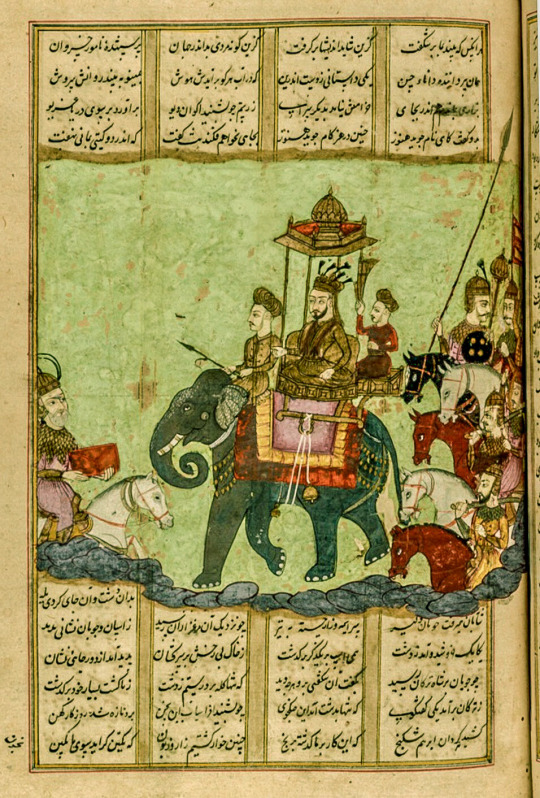
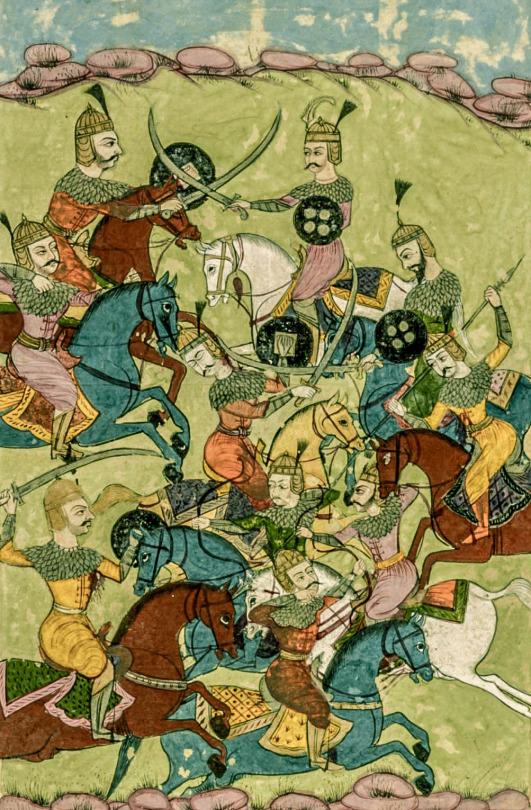
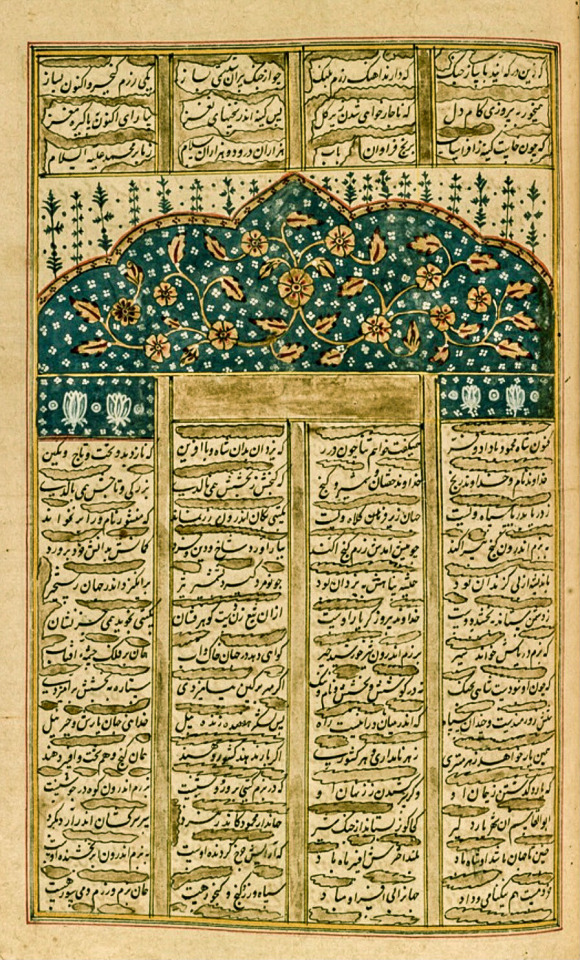



source [The Library of Congress]
#beautiful books#book blog#books books books#book cover#books#illustrated book#old books#incunabula#mythology and folklore#ancient persia
70 notes
·
View notes
Text
Embark on a timeless journey through
"Embark on a timeless journey through ""HERODOTUS BOOK II. THE THIRD BOOK OF THE HISTORIES, CALLED THALEIA: HERODOTUS (The Chronicles of Empires and Legends)"" by M. A. Bards, available now on Kindle. Dive into the world of Herodotus, the Father of History, who traversed ancient empires, documenting the sagas of gods and mortals. This third book is your portal to the past, where you'll sail across the wine-dark seas, scale the mountains of Persia, and wander through the sands of Egypt.
Experience the stories that shaped humanity: the rise and fall of great empires, the deeds of heroes, and the origins of civilizations. Guided by Thaleia, the Muse of History, ""HERODOTUS BOOK II"" is not just a book; it's an odyssey that reveals the rich tapestry of human history, woven from the threads of countless lives and legendary tales.
Start your odyssey here: https://www.amazon.com/dp/B0CZ8QV9Y6
Embrace the adventure, and let history illuminate the paths of the present and future."
#books#bookstagram#book#booklover#reading#bookworm#bookstagrammer#read#bookish#booknerd#bookaddict#booksofinstagram#bibliophile#instabook#love#bookshelf#readersofinstagram#booksbooksbooks#bookaholic#libros#reader#bookphotography#b#booklove#art#author#libri#literature#instabooks#booklovers
1 note
·
View note
Text
"Shahnameh" (also known as "Shahnama" or "The Book of Kings") is a Persian epic written by the poet Ferdowsi in the early 11th century.
The work is one of the most important in Persian literature and tells the epic story of the Persian kings from the creation myths to the Muslim conquest of Persia.
Main features of "Shahnameh":
Written by Ferdowsi: Composed by Ferdowsi over a period of several years, the "Shahnameh" was completed in 1010 A.D. and consists of more than fifty thousand verses in the Persian language.
Ancient Persian History: The epic covers the history of Persia from creation myths and legends to the Islamic conquest. Includes accounts of legendary kings, epic battles, heroes, love and betrayal.
Preservation of Persian Identity: The "Shahnameh" played a crucial role in preserving Persian cultural and linguistic identity after the Arab conquest. Ferdowsi chose Classical Persian as the main language of the work, contributing to the preservation of the Persian language.
Characters and Stories: Includes a rich and varied gallery of characters, such as Rostam (a mythical hero), Zal (Rostam's father), Sohrab (Rostam's son), and many others. The stories contain mythical, epic and romantic elements.
Cultural Influence: The "Shahnameh" profoundly influenced Persian literature, art and culture. His stories and characters continue to be sources of inspiration for various forms of artistic expression.
The "Shahnameh" is considered a masterpiece of world literature, testifying to the rich cultural and historical heritage of Persia.
edisonmariotti @edisonblog
.br
"Shahnameh" (também conhecido como "Shahnama" ou "O Livro dos Reis") é uma epopeia épica persa escrita pelo poeta Ferdowsi no início do século XI.
A obra é uma das mais importantes da literatura persa e narra a história épica dos reis persas desde os mitos de criação até a conquista muçulmana da Pérsia.
Principais características do "Shahnameh":
Escrita por Ferdowsi: Composta por Ferdowsi durante um período de vários anos, o "Shahnameh" foi concluído em 1010 d.C. e consiste em mais de cinquenta mil versos em língua persa.
História Persa Antiga: A epopeia abrange a história da Pérsia desde os mitos e lendas da criação até a conquista islâmica. Inclui relatos de reis lendários, batalhas épicas, heróis, amor e traição.
Preservação da Identidade Persa: O "Shahnameh" desempenhou um papel crucial na preservação da identidade cultural e linguística persa após a conquista árabe. Ferdowsi escolheu o persa clássico como a língua principal da obra, contribuindo para a preservação da língua persa.
Personagens e Histórias: Inclui uma galeria rica e variada de personagens, como Rostam (um herói mítico), Zal (pai de Rostam), Sohrab (filho de Rostam), e muitos outros. As histórias contêm elementos míticos, épicos e românticos.
Influência Cultural: O "Shahnameh" influenciou profundamente a literatura, a arte e a cultura persas. Suas histórias e personagens continuam a ser fontes de inspiração para diversas formas de expressão artística.
O "Shahnameh" é considerado uma obra-prima da literatura mundial, testemunhando a rica herança cultural e histórica da Pérsia.

1 note
·
View note
Text
Honor (timē) & Alexander
I’m reading through several chapters in the Brill’s Companion to Alexander the Great, edited by Joseph Roisman (2003) and I want especially to recommend Joseph (Yosi) Roisman’s “Honor in Alexander’s Campaign,” Chpt. 11, pp. 279-321 (yeah, it’s long). I half-think he wanted to edit that collection just to write that chapter. LOL. I give the citation because most people (not libraries) can’t afford Brill books. Even used, it’s well over $100 on Amazon. BUT there is this thing called “ILL” (Interlibrary Loan), which even public libraries will usually do for you, if perhaps for a (small) fee. You can have the chapter copied, or ILL the entire book and read more in it. Back before I was doing a phud, just wanted to read all these articles and books, I made copious use of ILL at my public library in Tampa. (Also, at the link above, you can purchase a copy of just that chapter. ILL is probably cheaper.)
ANYway, I want to recommend the chapter because Yosi manages to explain quite well (in readable fashion with minimal untranslated Greek/Latin) the concept of “honor,” or timē (pronounced tee-MAE) and its importance to Greek (and Macedonian) society. Timē is a tough word to translate. Honor is only part of it: esteem, regard, public standing...all those work too. As I tell my students in Greek History, when I introduce the “Greek virtue triad” of agonia (competition), aretē (personal excellence), and timē (honor/public regard)--each leading to the next--if you “get” these three concepts, the Greeks (and Macedonians) make sense. If you don’t, they appear to act crazy at times. Timē isn’t a matter of life and death...it’s more important than that!
Yosi dissects timē in the Macedonian context, how Alexander used it to reward or punish others, and how others viewed him with regard to it. While there are some details with which I quibble (below), I would really recommend this chapter to anyone who wants to better understand Alexander in his historic, cultural context. There are a lot of things between now and then which are really different, not least that seeking timē (= personal renown) and fame wasn’t a bad thing. TOO much boasting was hubris because that tread on the robes of the gods, but if you didn’t toot your own horn, nobody else would toot it for you. (One of ATG’s flaws was over-boasting/hubris, noted even in antiquity, especially when he’d been drinking.)
As I said long ago in my review of Oliver Stone’s “Alexander,” one of the “hard sells” about Alexander to a modern audience (which I also dealt with in writing Dancing with the Lion) is that, these days, we prefer our heroes humble. The Greeks didn’t. Humility is a Christian virtue, not Greek, and even for those who aren’t Christian, that view of humility is DEEP in our Western society. Some cultures (mostly Med) still elevate machismo, but especially in English-speaking countries, we prefer our heroes and celebrities humble, approachable, and friendly. We want Spiderman. Or Frodo. Or Tom Hanks. Prima donnas like Jennifer Lopez or Christian Bale (or Jared Leto, these days) don’t get a lot of respect.
Even in “democratic” societies like Athens, competition was still MAJOR, and if they wanted equality, it was only with regard to someone else. “There are no poor men, only rich men waiting to be,” is a Greek saying, and also applies to antiquity. None of this humble bragging shit. Sophrosunē, or self-control, and moderation were also admired, but humility was not a virtue.
That said, there are still arenas reminiscent of ancient Greece/Macedon. Take rappers, or boxers. Baseball players are taught how to give “humble” interviews--”I just wanted to help the team....” But boxers are expected to trash-talk opponents. And rapper battles are legendary. Both are more legal versions of the mob, or gangs.
Think of the Greeks and Macedonians like a bunch of rappers, shouting to the rooftops what they can do best and dissing the competition.
So, if you prefer, you can view Hephaistion vs. Krateros as 2Pac vs. Biggie. ;)
Yosi explains why (albeit without the rapper reference, ha). He also explains how this often fell out in real-world ways, so it’s not just theory (one reason the chapter is so damn long). He talks about everything from proximity to the king, to officer assignments, to the importance of a royal kiss.
A couple personal quibbles, the biggest being that I think Yosi is more inclined to credit ATG with divine aspirations, without qualifying it. In the “Did Alexander really think he was a god?” matter, the problem is “define ‘god.’“ The Greeks (and Macedonians) had a hierarchy of divinity. It wasn’t “divine” and “not divine.” We have deified heros (like Herakles, Dionysos...and Alexander) some of whom wound up as constellations (the dioscuri, or the Twins), then the “little divine things” (daimonē), then lesser nature spirits like nymphs, satyrs, etc., then divine concepts like “justice” (Dike) and victory (Nike), then lesser divinities/natural forces like Night, Death, Sleep, even the Titans, then finally we get to the Olympians (Zeus and family) + major chthonic deities (Hades, Persephone, Hekate).
So there is a BIG-ASS difference between claiming to be heroized, such as Achilles or Herakles, and claiming to be ZEUS. Son of Zeus does not make one divine, btw. The heroes died, even the later deified ones. Yosi doesn’t really get into that, and I think it’s critical. At no point did Alexander put himself on a par with the Olympians, or really most immortal divinities. He expected to be heroized at his death.
There are a few other things, such as my disbelief that burning Persepolis was a drunken revel (it was calculated and planned for; the drunken inspiration was Greek propaganda), or that Alexander braved Gedrosia just to show up Cyrus and Semiramis. By that point, he’d come to appreciate boats and trade, so I believe he was looking at sea lanes. Yosi wants to make it about him competing against heroic historical figures.
But in the scope of things, these are minor. I recommend you (somehow) lay hands on that chapter and read it. I’ll probably be assigning it when I teach my ATG class again next spring (2022).
There are some other good chapters in the Companion too, btw. I especially like Maria Brosius’s on ATG and Persia.
#timē#Alexander the Great#ancient Macedonia#Campaigns of Alexander the Great#honor as a Greek virtue#humility was not a virtue#Understanding Alexander the Great#Joseph Roisman#Brill's Companion to Alexander the Great#Classics#tagamemnon
26 notes
·
View notes
Text
“A millennium of detailed descriptions of Amazons presented as history began with Herodotus (fifth century BC) and continued through the late antique authors Orosius and Jordanes (fifth–sixth centuries AD). Between the lifetimes of these men, many other Greek and Roman historians also chronicled the origins, rise, and fall of the legendary Amazon “empire.” Each of these writers had access to texts and unwritten traditions that no longer exist today. Their accounts commingle fact and fancy, legend and history, but all identify the women called Amazons as Scythians.
Herodotus, the inquisitive Greek historian from Halicarnassus (Caria, part of the Persian Empire), preserved a treasury of information about the many tribes of Near and Far Scythia, based on personal observations, local histories and legends, and interviews. Admiration for resourceful, self-reliant Amazons is evident in Herodotus’s “historical” account of the origin of the Sarmatians. That story (recounted in the next chapter) tells how a gang of Amazons from Pontus joined a band of young Scythian men from the northern Black Sea and relocated to form a new ethnolinguistic group, a realistic option in the nomadic context of flexibility, alliances, and constant movement around the Black Sea and steppes.
About a century after Herodotus, in 380 BC, the Athenian orator Isocrates named the three most dangerous enemies of Athens: the Thracians, “the Scythians led by the Amazons,” and the Persians. Isocrates was harking back to glorious victories when “Hellas was still insignificant.” He reminded his audience that the first Athenians had repelled an “invasion of the Scythians, led by the Amazons.” Isocrates was alluding to the mythic Battle for Athens, which the Athenians treated as a historical event (chapter 17). After their defeat, Isocrates recalls, the army of women did not return to Pontus but went to live with their Scythian allies in the north. The Greek historian Diodorus of Sicily (65–50 BC) also wrote about Amazons, associating them with Saka-Scythian women who were as brave and aggressive in battle as the men. He pointed to the historical example of Zarina, who led a Saka-Parthian coalition to victories against tribes who wanted to enslave them (her story appears in chapter 23).
For his research on Amazon history, Diodorus consulted works by Ctesias (a Greek physician who settled in Persia around 400 BC) and Megasthenes (a Greek ethnographer who traveled to India ca. 350–290 BC). According to Diodorus’s sources, after a series of “revolutions” in Scythia, the Scythians were often ruled by strong women “endowed with exceptional valor”; they “train for war just like the men and in acts of manly courage they are in no way inferior to the men.” Many of these women accomplished “many great deeds, not just in Scythia, but in the lands bordering Scythia.”
At some point in the past, Pontus became home to a Scythian group governed by women who rode to war beside their men. One woman (Diodorus does not give her name) possessed extraordinary authority, superb intelligence, physical strength, and battle prowess. This brilliant leader trained a handpicked force of fighting women and began subduing neighboring lands. She founded Themiscyra at the mouth of the Thermodon in Pontus. Filled with pride “as the tide of her fortunes” rose, she began calling herself “Daughter of Ares,” the war god. Under this “kindly ruler beloved by her subjects, young girls were taught to hunt and they drilled daily in the arts of war.” She continued to lead her special army on wars of further conquest, advancing as far north as the Don River. So far there is nothing incredible in Diodorus’s account of a group of Scythians led by a successful female commander at some point in the distant past.
But in the following passage we can glimpse mythography in process, as the plausible is transformed into something more sensational. Ordinary Scythian society is twisted into an ominous “rule of hubristic women” scenario, a reversal of what was normal in the Mediterranean world, bound to titillate Diodorus’s audience. This powerful “queen,” declares Diodorus, enacted new laws that created a true gynocracy in Pontus, in which the women would always be sovereign and trained for warfare. She assigned men to domestic tasks, spinning wool and caring for children. She ordered that baby boys’ legs were to be maimed and girls would have one breast seared. From then on, Diodorus tells us, this Scythian tribe ruled exclusively by women was known as the Amazons and their queens were called “Daughters of Ares.”
This first great Amazon queen died heroically in battle. Her daughter (also unnamed) surpassed her mother’s great accomplishments, relates Diodorus, conquering lands around the Black Sea from the Don to Thrace, and she even made forays south into Syria. For many generations, these queens’ descendants continued to advance the Amazon nation in power and fame. Their decline began when the Greek hero Her- acles killed their queen, Hippolyte. Then Theseus abducted Antiope and made her his wife in Athens. In retaliation, the Amazons, aided by other Scythians, invaded Greece and besieged the Acropolis. But meanwhile, the native Anatolians they had conquered saw a chance to ex- ploit the Amazons’ absence. They united to make war against the few Amazons guarding Pontus.
These wars were so successful, says Diodorus, that the great race of Amazons of Pontus was essentially erased from history. Soon the Amazons were so diminished that only a few scattered bands remained. One of these small vestigial bands, led by Penthesilea, helped to defend Troy in the legendary Trojan War. People “in my day wrongly consider the ancient stories about the Amazons to be fictitious tales,” declares Diodorus. He explains why. After the Amazons lost the great Battle for Athens, the surviving Amazons gave up the idea of returning to Pontus, because it was ravaged by wars while they were away. Echoing Isocrates, above, Diodorus says the defeated Amazons accompanied their allies “the Scythians, into Scythia.” Thus the great Amazon empire vanished—absorbed back into the steppes of Scythia.
Strabo, a well-traveled native of Pontus, also speaks of the Amazons as an ethnic group consisting of both men and women. These people had once lived on the coast of Pontus, “the plain of the Amazons,” but were driven out. Strabo reports that some say they still live in the mountains of Caucasian Albania (eastern Georgia and Azerbaijan), while others place them in the northern foothills of the Caucasus. According to Strabo, the Amazon tribe was seminomadic and not all female. “When they were at home, they planted crops . . . and raised and trained horses, but the bravest among them spent most of their time away, hunting on horseback and making war.” Strabo’s account is another realistic description of a typical pastoral, seminomadic lifestyle, in which men and women could choose to hunt and campaign together or in segregated groups.
Scythians and Amazons received special attention in a work of the first century BC by Pompeius Trogus, a historian of Celtic roots with encyclopedic knowledge. His lost history was summarized and elaborated by Justin, who probably lived in the second century AD. The Scythians are described as battle-hardened warriors who prized inde- pendence and repelled all would-be conquerors. Trogus and Justin are clear that Amazons were Scythian women, capable of making war when they chose to. Scythian men and women were equals in heroic exploits, remarks Justin, making it “difficult to decide which of the two sexes had the more distinguished history.” Scythian men founded the Baktrian and Parthian empires, he reports, while Scythian women founded the Amazonian empire.
Once when the Scythian men were away for fifteen years making war in Asia, the women sent their husbands a message: If you don’t return home we will have sex with the neighboring tribe and the result- ing children will carry on the Scythian race. This story appears to refer to the seventh–sixth centuries BC during the Scythians’ conquests across western Asia, when there would have been long spans of years when most of the men were away. This theme of Scythian women taking up with other men of their own choosing recurs in many nomadic and Amazon traditions.
Herodotus, for example, relates that while the Scythians from the Don region were away for nearly thirty years campaigning against the Cimmerians and Medes, their women “consorted with the male slaves.” The women and their new consorts not only raised a whole generation of children to adulthood, but together they created an army to oppose the male warriors when they came home. In Justin’s account, the men returned home after receiving their women’s message. But in his detailed story of the origin of the Amazons of Pontus we hear about yet another group of resourceful Scythian women whose men had been killed in battle.
On the northern Black Sea, wrote Justin, two young Scythians named Plynus and Skolopitus were forced out of their homeland by a faction. They assembled a large band of young men and traveled south over the Caucasus Mountains and occupied Pontus. “From their new base in Pontus, they plundered the nearby lands for a long time.” At last, the native peoples rose up. They ambushed and slaughtered most of the Scythian men. “The Scythians’ wives now perceived that they were widows as well as outsiders. They took up arms and defended their territory. And then the women went on the attack. They refused to marry, calling it slavery.”
These women, says Justin, “embarked on an enterprise unparalleled in all history,” creating and defending a state without men. They even killed the hus- bands who had survived by remaining at home, so that no woman would seem more fortunate than those who had lost their men. Next they avenged their husbands’ deaths by destroying the guilty local tribes. In the peace that followed, they had sex with neighboring peoples so that their bloodline would not die out. The Amazons of Pontus killed baby boys and raised the girls to ride horses, kill game, and train for combat “instead of keeping them in idleness or working with wool” like Greek wives.
An earlier fragmentary version of this Amazon origin tale comes from the geographer Skymnos of Chios (ca. 185 BC). In his account, a group of Maeotians led by two young men named Ilinus and Skolopitus journeyed from the Sea of Azov over the Caucasus and settled in Pontus. After the men were killed by an uprising of the natives, the women took up arms and became successful warriors in their own right. The warrior women were later conquered by the Greeks and dispersed back to the north. These “Amazons and their husbands” migrated back to the land west of the Don and continued to be known as Maeotians. Skymnos clearly identifies Amazons as women of Scythian origins. See chapter 22 for a historical warrior queen of the Maeotians, Tirgatao.)
The geographer Pomponius Mela, writing in about AD 43, located Amazons on the steppes around the Don, the Sea of Azov, and the Caspian Sea, and also in the vast expanse eastward toward the land of the Seres (“Silk People,” China). In Pontus, on the Thermodon plain, a place called “Amazonius” had long ago been an encampment of Amazons when they dominated Anatolia. They had worshipped Artemis at Ephesus and named the town of Cyme on the Aegean coast after the Amazon leader who drove out the native inhabitants (Cyme issued coins showing an Amazon and a prancing horse). The steppes, he wrote, are rich in pastures and they are occupied by the Amazons. The Maeotians around the Sea of Azov are called Gynaecocratumenoe (“Ruled by Women”). The men are archers on foot, while the women ride on horse-back and lasso enemies with lariats. There is no predictable age for women to marry, noted Pomponius Mela, because the women remain single until they prove themselves in battle.
Pliny the Elder, the Roman natural historian writing in about AD 70, uses words and names similar to those used by Skymnos and Pomponius Mela. Pliny calls the Sarmatians Gynaecocratumenoe (“Ruled by Women”) and also refers to the “Amazons and their husbands.” A century later, during the Roman defeat of the Goths in Thrace (AD 270– 275), the Romans referred to the captive Gothic women as “Amazons.” Orosius, a learned and well-traveled Christian historian of the early fifth century AD, consulted numerous classical sources, such as Livy, Tacitus, Diodorus, and Justin, as well as Trogus and other texts that no longer survive, including traditional foundation tales of cities that claimed Amazons in their past. In his History Against the Pagans, Orosius tells how the Amazons came to rule in long-ago Pontus. Orosius’s history recaps Diodorus’s account, above, but supplies proper names and details from Justin’s account.
Orosius also inserts his own views. One of Orosius’s important sources was Justin, who reported that the ancient Amazons of Pontus were ruled by a pair of queens named Martesia (Marpesia, “Snatcher or Seizer”) and Lampeto (Lampedo, “Burning Torch”). Justin says the corulers divided their all-women forces and took turns leading conquering armies and defending Pontus (Orosius says they drew lots). According to Orosius, Lampedo led the invading Amazon army to subdue most of Thrace and captured some cities of Anatolia, founding Ephesus and other towns. Her victorious army “laden with rich booty,returned to Pontus.But she found that the other half of the forces that had remained with Queen Marpesia to protect their empire had been cut to pieces in a battle.”
Marpesia’s daughter, Sinope, succeeded her mother, giving her name to Sinope in Pontus. As a “crowning achievement to her matchless reputation for courage,” says Orosius, Sinope remained a virgin to the end of her life.” So great was the “admiration and fear spread by her fame” that when Heracles was ordered to bring the weapons of the Amazon queen to his master, he was “certain that he would face inevitable peril.” Orosius expected his Christian audience to be shocked and outraged by the “shame and human error” of powerful women of antiquity willfully dominating men, choosing foreign lovers, killing baby boys, building cities, and marching out to conquer. Unlike Justin, who plainly admired the “unparalleled enterprise” of the women, Orosius is the first ancient writer to explicitly express disapproval of the “unnatural” state of independent Scythian women who behaved as the equals of men. Yet even Orosius cannot suppress his admiration for the Amazons of yore. In a surprising conclusion, Orosius praises the sublime courage of the four greatest Amazon queens, Hippolyte, Melanippe, Antiope, and Penthesilea.
Notably, in 2006, archaeologists discovered magnificent life-size portraits of the famous quartet of Amazon queens, Hippolyte, Antiope, Melanippe, and Penthesilea, in a mosaic floor of the ruins of a villa under a parking lot in ancient Edessa (Sanliurfa, Turkey) . The action-packed scenes are unusual because they show the queens hunting lions and leopards instead of making war. The spectacular mosaics at the Villa of the Amazons were made in the fifth or sixth century AD, in the period when Orosius was writing his history of the pagans. The power of ancient Amazon stories to thrill had not faded after four centuries of Christianity.
Another author of later antiquity, an Alan-Goth from the northern Caucasus named Jordanes, wrote a fascinating history of the Goths— laced with heaping doses of fiction—in AD 551. Jordanes, who had access to ancient Gothic and Alan traditions, portrayed the Goths, who migrated from Europe to the steppes, as the heirs of the Scythians “whom ancient tradition asserts to have been the husbands of the Amazons.” Here is yet another succinct expression of the ancient understanding of Amazons as Scythian women. Jordanes says that the Amazons once dwelled around the Sea of Azov, from the Borysthenes to the Don—and he claims the Amazon queens Marpesia and Lampeto as the ancient “ancestors” of the Goths.
In Jordanes’s Gothocentric version of the old legends told by Justin and Orosius, long ago while the Goth men were away on an expedition, an enemy tribe attempted to carry off the Goth women. But “they made a brave resistance, as they had been taught to do by their husbands.” After routing the attackers, the Goth women “were inspired with great daring.” They took up arms and chose as their leaders the two boldest women, Marpesia and Lampeto. In this Gothic rendition, it was Marpesia who led an army of conquest while Lampeto stayed to guard their native land. On her campaigns Marpesia and her Amazon army encamped for a long time at the eastern tip of the Caucasus range where it meets the Caspian Sea (ancient Caucasian Albania, now Dagestan), one of the major nomad migration routes described earlier. This place, says Jordanes, was thereafter called the “Rock of Marpesia.” This legend was already known in the first century BC to Virgil, who calls it the “Marpesian Cliff.”
Jordanes lists the glorious conquests across Anatolia and Armenia by the “Scythian-born women who had by chance gained control over the tribes of Asia and held them for almost a hundred years, before returning to their kinsfolk at the Marpesian Rock.” Amazons retained “power in that region up to the time of Alexander the Great” (here Jordanes alludes to Alexander’s meeting with Amazons on the southern shore of the Caspian; chapter 20). By Jordanes’s time—more than a thousand years after Homer and Herodotus—the fame of the warlike Scythian women, called Amazons, evoked such respect and awe that the legendary Amazon queens were claimed as ancestors of the powerful Goths.”
- Adrienne Mayor, “Scythia, Amazon Homeland.” in The Amazons: Lives and Legends of Warrior Women across the Ancient World
18 notes
·
View notes
Text
Greece: A historical essay - Part 1/4
On the 25th of March 2021, the people of Greece celebrate their independence day. This year is especially important because it is exactly 200 years since the outbreak of the revolution (1821). I decided to honor my country and its history with a (relatively) detailed post.
Most people around the world already have knowledge regarding ancient Greece, so I will be brief here.
ANCIENT AND ARCHAIC GREECE:
between 3000 and 1100 B.C. roughly, there existed the Minoan civilization of Crete. We know little about them besides their elaborate palaces (anaktora), intricate plumbing systems and wonderful frescoes. They used the linear A in their writing, which remains undeciphered to this day. This civilization was one which traded with the outside world. Being an island, they also did not have many fortifications, which might have contributed to their downfall. There are 2 main theories as to their decline: Invasions from the mainland Mycenaeans or the major volcanic eruption of Santorini around that time.




Pictured above: 1) a partially destroyed room, allowing a peek inside 2) some restored frescoes 3) an outer room 4) A showcase of the simple and geometric, yet elaborate and colorful, structure of the building. All of these pictures are from the Palace of Knossos.
The next civilization to succeed them were the aforementioned Mycenaeans, who thrived between 1650 and 1200 B.C. They originally lived in the Peloponnese peninsula, on the southern tips of mainland Greece. It appears that they invaded and subjugated the Minoans at some point. They used linear B for their alphabet, which has successfully been deciphered and is our first indication of archaic or proto-Greek. The later tales of Homer (Odyssey and Iliad) are set in the 1200s and involve Mycenaean legendary heroes and rulers.
They were organized in independent and semi-independent city-state kingdoms, crafted bronze weapons and were a war-like people. Around 1200, we see an increase in fortifications around their settlements and the remains of their palaces carry signs of having been burned. This implies that they, too, fell to an invading force which had been threatening them.
The Minoans and Mycenaeans appear to have both used a centralized “manorial” or palatial economic system, which revolved around their grand palaces.
After their fall came the dark age of ancient Greece, which lasted from 1100 to 750 B.C. As implied by the name, we have very little information about this time. Pottery lost its elaborate design and became merely geometric, the linear B alphabet stopped being used, settlements were much smaller and fewer in population.
One other notable involvement is the arrival of the Doric tribes to the Greek mainland, displacing and possibly mixing with the Mycenaeans.
CLASSICAL GREECE:
This is the ancient Greece everyone knows and loves. The Dorians were not the only ethnic group of that time, with them appeared the Ionians, Achaeans, and Aeolians. In myth, these are all relatives who came from the same ancestor, Hellen (not the famous Helen of Troy, but instead a male patriarch from Thessaly).
The Achaeans might have had a relation to the Myceneans or have existed alongside them to some degree, This is only a hypothesis though.
The Dorians were the direct ancestors of the Spartans and Corinthians, among other smaller states of the Peloponnese.
The Ionians are best remembered as the ancestors of the the Athenians but also their many coastal and islander allies, including the region of Ionia (modern Smyrna/Izmir region) in Asia Minor.
The Aeolians lived in modern-day Thessaly and were the most numerous of the Greek groups. During the Doric invasion, some of them fled to the island of Lesbos and the region of Aeolis (which they named) in Asia Minor.
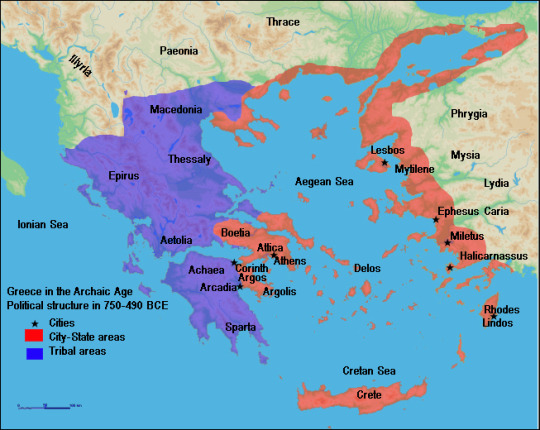
During this period we see the early foundations of what would evolve into the ancient Greek city-state model, as most imagine it, as well as the government forms of Classical Greece - Oligarchy, Democracy, Tyranny. These forms of government acted as ancient ideologies of sorts, to a degree.
In Sparta, Lycurgus implemented the reforms which led to the highly militarized, disciplined, regimented and isolationist Spartans of the Classical period.
In Athens, there was a succession of reformers who led to the establishment of Democracy. First was Dracon, the least democratic of all and whose laws give us the modern definition of the word “Draconic”, afterwards we have the moderate Solon, who can be credited with the foundations of Democracy and maintaining a balance between the aristocratic wealthy and the common poor. There was a brief interruption to democracy between 561 - 510 B.C. as the leader of the Democratic faction, Peisistratus, took the reins of power as a Tyrant (back then, the word had a neutral or even slightly positive connotation, along the lines of “benevolent dictator/enlightened autocrat). The laws and customs of Athenian Democracy were kept in place during those years and were able to blossom after the end of the tyranny. Cleisthenes was the next in the line of reformers. A radical democrat, he greatly expanded the power of the poorer citizens. All of these reforms led directly to the Athenian Democracy inherited by Pericles right before the Peloponnesian war and during the zenith of Athenian power, wealth and culture through its leadership of the Delian League.
Before that though, there were the Persian wars, which started when the coastal city-states and former colonies of Asia Minor cried for help to the Greek mainland, in an effort to avoid complete annexation by the Persian empire.
This led Greece to band together against the threat of the Persians and beat them back, after many losses and much hardship. This is considered the main grand epoch of the classical era and bound them all together as “Hellenes” for the first time.
Greece was not a place of long-lasting peace and alliances though. Soon after, the Athenian populist democratic politicians promised their people great opulence, which they could only ensure by taking from the common fund of the Delian League and using that money on their city. Thus Athens prospered at the expense of its supposed allies, leading to the era of Athenian Hegemony around the 5th century B.C. (Sparta used to be the hegemon before them, around 650 B.C.). This all lead directly to the Peloponnesian war of 431 - 404, where the Spartans emerged victorious after protracted campaigns and battles, gaining the title of “liberators” for dismantling the Athenian hegemony and liberating their tributaries.
During this period we also have the beginning of Greek philosophy as we know it, with the activity of Socrates. Pre-Socratic philosophers were generally natural scientists and cosmologists, he was the first to deal with moral and political philosophy, changing the term forever. Plato was his student, who famously wrote his own political system in “The republic” and unsuccessfully tried to implement it in Syracuse. Aristotle was the student of Plato and became the founder of Mixed government and Classical republicanism (as it was later known and developed later in the renaissance), he was also the teacher of Alexander the Great, the famous Greek-Macedonian king who created an empire.
Sparta’s attempt at aiding oligarchic tyranny in Athens, with the conclusion of the war, failed and Athens returned back, somewhat weak but still great, after only a few years. The next hegemon to take the title were the Thebans, the third most powerful city-state of the era. They held it for a short while in the 3rd century, until Alexander the Great’s father, Philip II, took that title from them, laying the groundwork for the later conquests of his son.
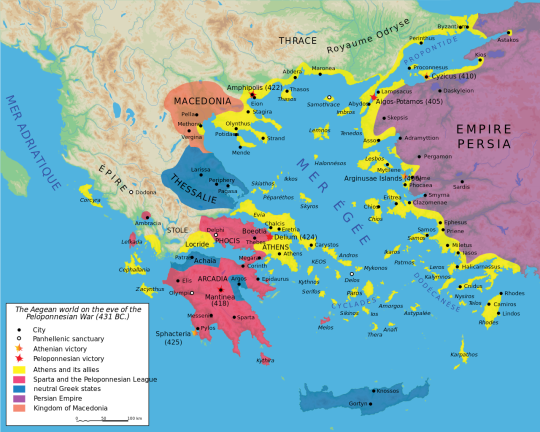
Alexander defeated the Persians, conquered Egypt, Babylon, Asia minor, Persia itself and finally modern-day Pakistan and Afghanistan, reaching the Indus river, where he finally met his equal at the hands an Indian kingdom and was forced to return back to Babylon, where he died.
His empire fractured into four successor states and Rome met little resistance, fighting only Epirus and a weakened Macedon, in their conquest of Greece.
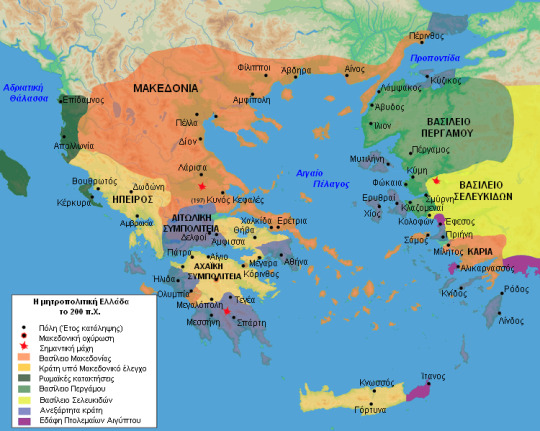
Pictured above: Greek states around 200 B.C.
Bright yellow: Seleucids
other Yellow: Achaean League, Epirus and states under Macedonian influence
Dark Blue: Aetolian League and Independent states
Orange: Macedon
Dark Green: early Roman conquests
Light Green: Kingdom of Pergamum
Purple: Ptolemaic (Egyptian) holdings
11 notes
·
View notes
Text
Alexander III “The Great”, King of Macedon (356-323BC) Part 1: The lay of the land...
His name conjures up all kinds of images and associations and the details of his life which spanned just shy of 33 years are far too expansive to be condensed into one post, so we’ll divide it into a few parts with a summary focus on what brought him to historical attention, his military conquests and some of his lasting impacts on culture and history. First a bit of personal and geopolitical background are necessary.
Alexander was born in July of 356 BC in what is the city of Pella in the ancient Kingdom of Macedon in modern northern Greece. His father was the then reigning King of Macedon, Philip II and his mother was one of Philip’s wives Olympias, a princess from another Greek kingdom, Epirus. Ancient Greece was divided into city-states or polis or various small petty kingdoms without a unified rule in the 4th Century BC. In centuries prior, Greece was dominated by two cities with two different systems of government and two different military traditions. One was Athens, a direct democracy with an advanced and powerful navy and the other was the largely land based diarchy (two co-ruling kings) of Sparta, which was famed for its infantry and harsh military indoctrination with a reputation as an almost unbeatable force in the Classical Greek world. Both played an important role in establishing Greek culture, philosophy, art, religion, military and government, all of which would contribute to modern Western Civilization.
Athens and Sparta were at times friendly but often rivals and most especially in the 5th Century BC with the invasion of Greece by the great superpower of the day in Eurasia, the Achaemenid Empire, better known as the Persian Empire from Iran. The Persian Empire spanned from the Indus River valley in modern Pakistan and India across Central and Western Asia, the Middle East, Northern Africa and Southern Europe, it was multiethnic, multilingual, multireligious, cosmopolitan and very influential on governance. It was centered in Iran, by the Persians, an Iranian people of the diverse Indo-Iranian ethnolinguistic group that overtook many others and expanded to become the predominant power of its age, probably in the entire world. The Greek or Hellenic world was on Persia’s western fringe, it was a tributary portion, subject to the Persians but with a modicum of independence. Persia’s provinces were divided into satrapies, ruled by royal governors called satraps. Persia invaded Greece under Xerxes I, its Shah or King of Kings in 480 BC. This united Greece and was famed for the stand of the Greek force, namely the 300 Spartans at the Battle of Thermopylae, which though a Persian victory was costly in lives and time, delaying the Persians. Eventually the Persians retreated due to rebellion back east and the force that remained was defeated by the Greeks, giving the Greeks breathing space to maintain their independence. In the wake of this victory though Athens and Sparta and their various other Greek allies turned on each other forming rival camps in the Peloponnesian War which saw Sparta defeat Athens and become the most powerful faction in Greece.
Meanwhile to the north in the highlands, Macedon was remote and rustic for a Greek kingdom, it was viewed as a backwater by its southern neighbors and some did not consider it Greek at all. Though they are believed to have spoke their own dialect of Greek, worshipped in the same polytheistic religion as Greece and shared certain other cultural traits with the southern Greeks. Nevertheless their proximity to the barbarian tribes of the Balkans, the Thracians, Dacians and Illyrians made them some what of a halfway point between “civilized” Greece and outright barbarians. However, the ruling dynasty into which Alexander was born, the Argead claimed descent from the legendary hero Heracles or Hercules and from there Zeus, God of Thunder and supreme on the Greek Pantheon of Olympian Gods. They were famed for their military tradition, including cavalry and their infantry. It was really Alexander’s father Philip who introduced the innovations to Macedon’s military that Alexander would perfect in later battles.
Their reforms were a result of technology, regimented drilling and a doctrine of combined arms, something most Greek military traditions up to that point ignored. Typical emphasis was on one branch of the military, in Athens it was naval warfare, in Sparta, a strong infantry and Thessaly a strong cavalry. Macedon lacked naval power at the time but it sought to emphasize both strong cavalry and infantry tactics in combined usage, one supporting the other throughout the battle. Philip adopted tactics from his enemies, including the light infantry tactics of the Thracians, the light cavalry of the nomadic horse archer Iranian Scythians including their flying wedge tactic. Most famously, Philip helped innovate a new technological and tactical formation, the phalanx.
The phalanx was a formation of regiments of heavy infantry using long spears called the sarissa, typically 18-20 feet long in units numbering 256 men each armed with a speared pike that was light in construction but due its length could keep the enemy at bay. Phalanxes were both defensive and offensive in nature. Its long spears meant it could defend itself at greater range in melee, deflecting cavalry and infantry charges head on and by going on the offensive and marching in formation, the phalanx could deploy to hold or press open the enemy line by fixing it into place in such a way that a gap could open for the Macedonian cavalry to exploit with its flying wedge formation, typifying the use of combined arms.
Macedonian troops were drilled constantly, almost as much as Spartans but in a much looser more flexible and adaptable doctrine, making them more well rounded than their Spartan counterparts. Philip would conquer the famed city of Thebes as well as defeat several barbarian tribes and went onto conquer much of Greece and got Athens to make peace but he never took on Sparta, nor did Alexander. Nevertheless, with Macedon now the dominant power over Greece, Philip was named Hegemon of the Hellenic League, making him in effect the ruler of a mostly unified Greece. His goal was to next invade the Persian Empire which was on the decline but he was assassinated by his own bodyguard.
At age 20, Alexander took the throne of Macedon, becoming the king but his rule was in jeopardy, Alexander, however was a learned young man, thanks to his father hiring the famed Aristotle to be Alexander’s childhood tutor. This well rounded classical education combined history, geography, mathematics, biology, philosophy and literature, all things which Alexander came to appreciate and support, but his military training was all from his father and his father’s trusted generals, many of whom Alexander now inherited himself.
Alexander would have to prove himself and his kingdom worthy of his father’s legacy while at the same time forging his own name. He defeated both Thracian tribes to the north in modern Bulgaria and other Greek states, which like his father named him Hegemon and in 334 BC when he crossed the Hellespont from Greece into Asia Minor (modern Turkey), his forces would embark on a ten year campaign that would change the world and one from which he would never return home...
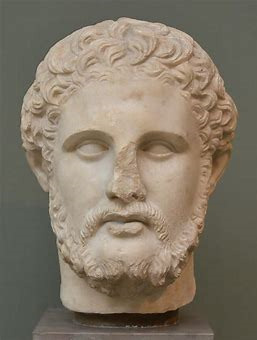
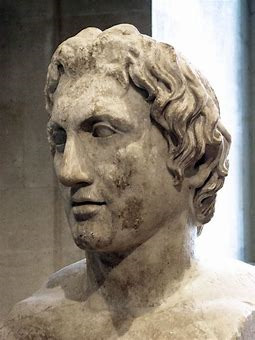
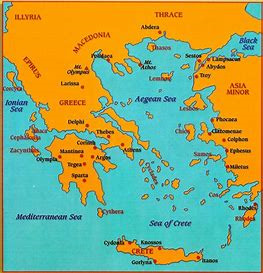
#Alexander the Great#philip ii of macedon#macedonia#ancient greece#ancient world#military history#persian empire#combined arms#military tactics#phalanx#sarissa#athens#sparta#aristotle#classical greece#4th century bc#5th century bc
9 notes
·
View notes
Text
Astrological Timeline
Early Influences
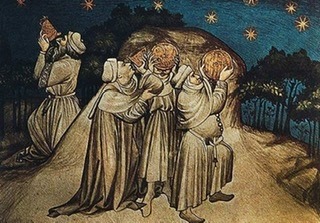
4242 BCE Egyptian calendar is one the first calenders in use, marking 12 months made of 30 days, with a year consisting of 360 days.
4000 BCE The basic concepts of astrology are first utilized in Mesopotamia. The Ziggurat at Uruk, Ur and Babylon, built by the Sumerians, are the first astrological observatories in the world, where early astrologers kept track of the Sun, the Moon and the five planets that they could see.
3000 BCE Egyptian calendar is revised to 365 days.
2872 BCE Sargon of Akkad, the first ruler of the Akkadian empire, is one the first to use astrologer priests to predict the future.
1200 BCE The Babylonians invent the written first systematic astrological system over thousands of years. The records survive in the form of the Babylonian star catalogs, making Babylonian astrology the oldest astrological system on Earth.
One of the earliest compilations is the Enūma Anu Enlil; meaning “When the Gods Anu and Enlil…” It is composed of approximately 70 astrological tablets, which include around 7000 predictions. The Babylonian astrological system was very omen-oriented, and such records were kept to predict the state of the king and the nation as a whole.
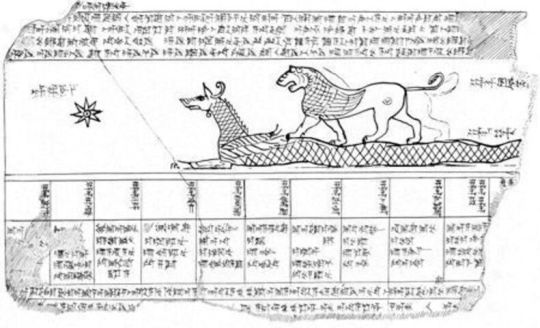
1000 BCE The MUL.APIN, was compiled, which consisted of the most significant star lists in Babylonian astrology. It contained 71 stars and constellations as well as their rising and setting times. The stars were also associated with specific deities. The Babylonians originally listed 17-18 constellations, but in later revisions, the number of constellations was reduced to 12 major ones. Many believe copies of the tablets carried astrology from Babylon to India, sometime between 400 and 300 BCE.
Babylonians recognized five planets—Jupiter associated with God Marduk, Venus with Goddess Ishtar, Saturn with Ninurta, Mercury with Nabu and Mars with Nergal.
The 12 Babylonian Astrological Signs
GU.AN.NA – Heavenly Bull, The Bull of Heaven (Taurus)
MASH.TA.BA – Twins, The Great Twins (Gemini)
AL.LUL – Pincers, Crayfish (Cancer)
UR.GU.LA – Lion, The Lion (Leo)
AB.SIN – Daughter of Sin, The Seed-Furrow (Virgo)
ZI.BA.AN.NA or GISH.ERIN – Heavenly Fate, The Scales (Libra)
GIR.TAB – That Which Claws And Cuts, The Scorpion (Scorpio)
PA.BIL.SAG – Defender, The Overseer (Sagittarius)
SUHUR.MASH – Goat-Fish, The Goat-Fish (Capricorn)
GU.LA – Lord Of Waters, The Great One (Aquarius)
SIM.MAH – Fishes, The Tails, Swallow Tail (Pisces)
LU.HUNG.GA – Field Worker (Aries)

700 BCE The present day zodiac wheel was shaped by the wheel that the Babylonians created
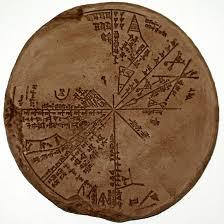
549 BC Cyrus the Great, the Achaemenid king of Persia, conquered Babylon.
572-490 B.C.E. Pythagoras, a Greek philosopher and mathematician, identifies the wisdom embodied within numbers, and theorizes that numbers are important to the universe, and they come together in harmony to create the world that we see. He was one of the first to refer to the universe as the Cosmos. His ideas were the foundation for the Pythagorean Theorem. His theory solidified the mathematics and science behind the planetary aspects that are used today. His ideas influenced some of the greatest philosophers in history.
535 BCE Pythagoras sets up a colony to learn about astrology, numerology and the occult arts - the Brotherhood.
475 BCE. Empedocles replaces the theory of matter with the theory that all of the substances derive from the four elements: fire, air, water and earth - which are the basic principles of developing astrological interpretations used today. He theorized that nothing can be created or destroyed, only transformed.
428-348 BCE. Plato's Timeus (360 BCE) identifies the universe as a living entity, composed of four elements (air, fire, water, earth) which distinguish each form by their molecular structure, although all four elements are interconnected and interrelated in a perfect harmonious form.
460 BCE. Hippocrates used earlier astrological and universal principles laid before him, and applied them to the study of the human body in relation to the rhythms observed within the universe as a whole.
409 BCE The oldest known horoscope chart is created
370 BCE Eudoxus of Cnidus invented a model of twenty-seven concentric spheres by which he was able to calculate the sun's annual motions through the zodiac, the moon's motion including its wobble, and the retrograde motions of the planets (27 Spheres, one for the fixed stars, three each for the Sun and Moon and four for each of the five planets). He created calendars using the zodiac with all 12 equal zodiac signs.
331 BCE Alexander the Great conquers Babylon and establishes the city of Alexandria. Under his rule, the Greeks further advances in astrology, along with developments in medicine, geometry, mathematics, and philosophy - furthering on the theories put forth by Pythagoras, Plato, Hippocrates, and Aristotle.
330 B.C.E. Berossus a Babylonian/Chaldean astrologer founds the School of Astrology at the Island of Cos. Many Greek astrologers learned and taught there.
330 BCE Alexander the Great spreads the knowledge of astrology throughout the Middle East. Greece personalizes astrology. The word astrology itself is derived from the Greek word for "star," and the word zodiac which means “the circle of animals.” The Greeks borrowed some of their myths from the Babylonians and invented many of their own, such as adding the names of their heroes to the constellations. The animals representing the signs were placed among the stars usually for great acts of heroism, and were usually associated with the Greek gods. The Greek words were translated to the Latin words that are used today.
290 BCE The legendary Alexandria becomes the center of astrological research.
250 BCE Achinapolus and Antipatrus teach medical astrology based on the teachings of Berossus. They begin to experiment with natal horoscopes.
207 BCE Galen, a Greek physician, combines the teachings of Plato, Aristotle, and Hippocrates, building upon them to create a functional system, for human anatomy and medical theories. He built upon Hippocrates earlier theory, that health requires an equilibrium between the four main bodily fluids, or humours—blood, yellow bile, black bile, and phlegm. Each of the humours is built up from the four elements and displays two of the four primary qualities: hot, cold, wet, and dry. He was one of the first to argue that humoral imbalances can be located in specific organs, as well as in the body as a whole. This modification of the theory allowed doctors to make more precise diagnoses and to prescribe specific remedies to restore the body’s balance.
200 BCE Astrology for predicting the future appears in Rome.
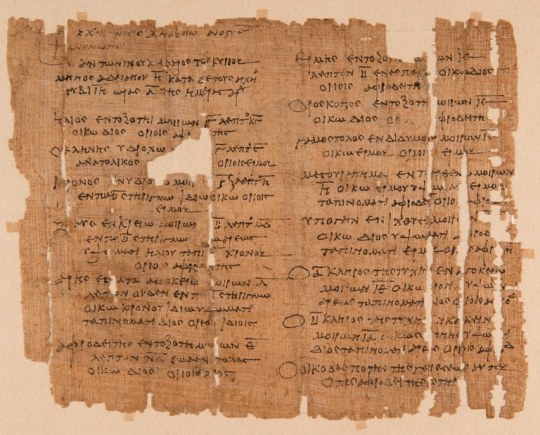
Papyrus with Greek Horoscope of Anubion Son of Psansnos , 2nd century CE, from Thebes, Egypt, Musée du Louvre, Paris, Département des Antiquités égyptiennes
100 BCE The Essenes develop the Qabbalah and esoteric astrology.
60 BCE First school of astrology opens in Rome.
7 BCE The birth of Christ is predicted by three Magi astrologers, using a star.
150 CE Ptolemy, a Greek astrologer and mathematician published the Tetrabiblos, which was one of the most revered astrology works ever written. The Tetrabiblos contained the core techniques of astrology including planets, zodiac signs, houses, and aspects, which are still relevant and heavily used today.
400 CE The Library of Alexandria containing many of the world’s texts on astrology is destroyed.
474 CE European astrology in decline after the Fall of the Roman Empire.
600 CE The Church condemns astrology and tries to suppress it.
639 CE Egypt is invaded and taken over by the Islamic Empire. This marks the end of the Hellenistic astrological tradition.
750 CE Muslim astrologers revive Greek astrology.
787-886 CE Arabic astrologer Abu Ma‘shar al-Balkhi writes the Kitab al-Madkhal al-kabir ila ‘ilm ahkam al-nujum (The Great Introduction). This was one of the most comprehensive astrology books written, that detailed scientifically, the astral influences on the material world, and the human body and life. The Great Introduction was translated into Latin first by John of Seville in 1133 CE.
801-873 CE The book De radiis stellicis (On the Stellar Rays) is written by Ya‘qub ibn Ishaq al-Kindi, which further combines Galen’s work, with Arabic astronomy, setting a precedent for medical treatments using astrology.
~ 1000 CE. Majriti (pseudo name) composes the Ghayat al-Hakim (The Picatrix), whose fundamental objective is to teach its reader how to determine the appropriate astrological time to contact celestial spirits and then “draw down” their essence by inducing them into a talisman created with materials which are sympathetic/resonate to, that particular spirit.
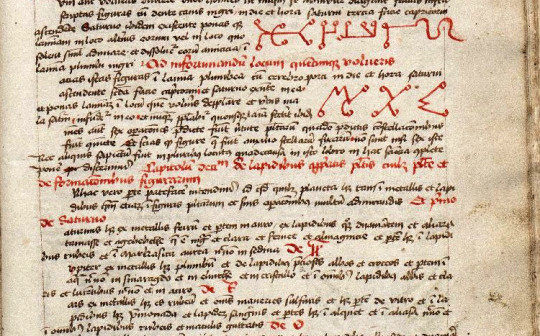
A page from the Picatrix
~1000 CE. Ibn Yunis, Moslem astronomer, compiles the Hakamite tables of planetary motions at Cairo.
1020 CE. Firdausi, or Abul-Qasim Mansur, Persia's epic poet, writes the Sah-Namah of over 60,000 couplets, containing many astrological references.
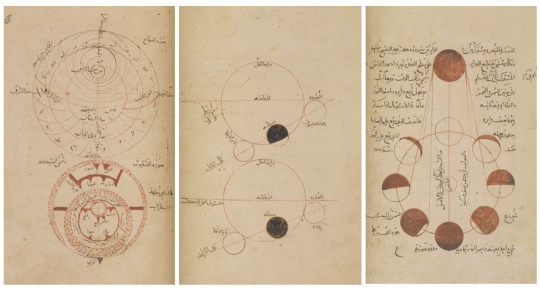
Kitāb al-tafhīm li-awā’īl ṣinā‘at al-tanjīm, Biruni, 11th century
~1114-1187 CE. Gerard of Cremona translates the Crises and the Critical Days from Arabic to Latin, allowing these great works to influence the educational climate of the time.
1200 CE The University of Bologna that was established in 1088 CE, becomes the center for learning medical astrology.
~1240-1311 CE. Arnald of Villanova wrote De iudiciis astronomiae, in which he wrote an influential treatise on the application of astrology to medicine. He combined Arabic teachings with Galen’s Critical Days, and used them to determine many methods of treating patients.
1250 CE Ancient magic and astrology is linked in the Speculum Astronomiae by Roger Bacon.
1255 CE Astrology is taught at Cambridge University in England. During this time Astrology is considered a science of the higher class, and many royals had court astrologers, and relied on them for predictions and medical advice.
1280 CE Johannes Campanus, an Italian astrologer and physician works for Pope Urban IV and develops a new way to divide astrological houses.
~1300 CE Almanacs (calenders) that contained star charts were employed by physicians, which allowed them to check the positions of the stars before making diagnoses. The book contained diagrams of the the body, and its corresponding star sign.

1399 CE Almanac diagram of the ‘Zodiac Man’
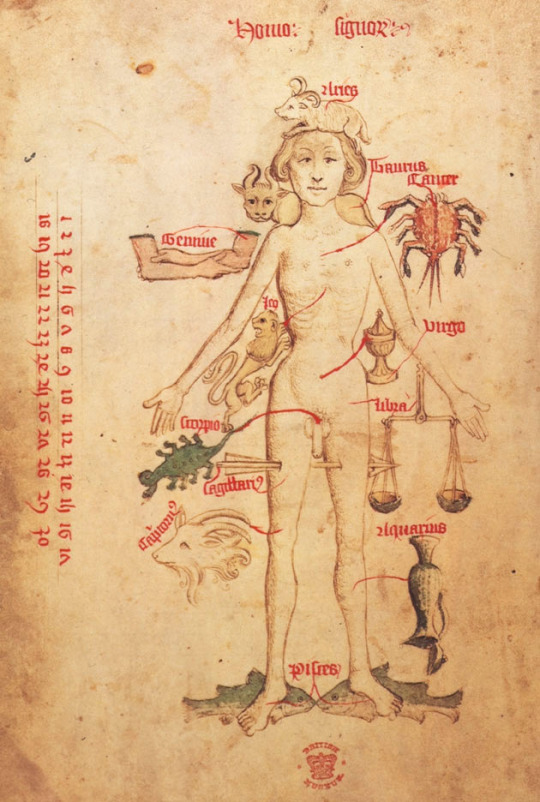
Diagram from a 1486 CE Medical Almanac
1400 CE The printing press is invented which allows mass production of astrological writings to be distributed in Europe. The Vatican promotes the instruction of astrology, with many Popes that were astrologers, and many served royal families in England, Italy, France and Austria.
1555 CE Andrew Dygges publishes A Prognostication, Manuscript on Medical Astrology in London, which became widely used by physicians. It attributed the zodiac signs to the specific body parts and organs of the human body, usually depicted visually.
~1500s CE All over Europe, physicians were required by law to calculate the position of the moon before carrying out complicated medical procedures.
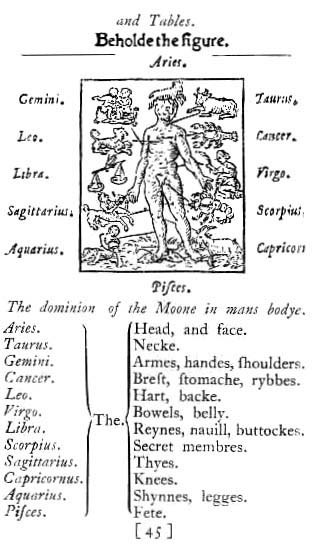
1603-1668 CE Placidus, a monk and mathematics professor, created the house division system used by astrologers today.
The renaissance period, marks the period of enlightenment, and ushers in a decline in the use of astrology as a science.
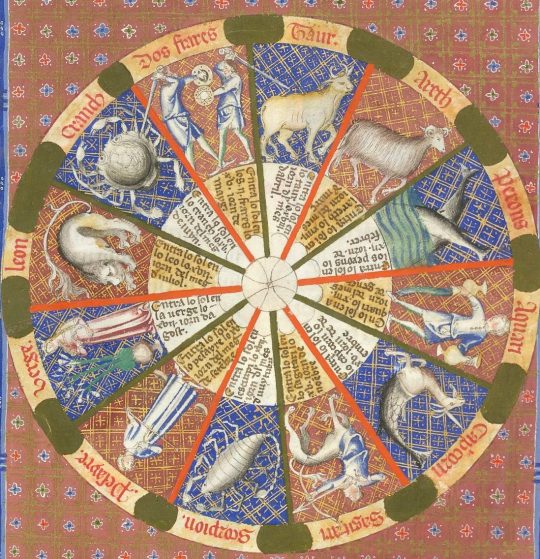
Solar Zodiologium – prognostications when the sun is in each of the signs of the zodiac. The writer offers advice related to daily life and health, matters that would readers would find useful in either the 15th century or the 21st.
4 notes
·
View notes
Text

Cú had chosen to watch rather than participate in the new tournament so that he could see and cheer on his dear student! The Lancer can’t stop grinning and he’s extremely proud of Arash! “See that guy over there? Look at him well because that’s Arash Kamangir! Not only is he the legendary great hero of Ancient Persia, but my one ( 1 ) and only student too! Isn’t he amazing and strong? Super cool, right?! Yes, yes, I helped him with his training but the result is just a reflection of his perseverance and now look at how strong he has become!”

The crowd with him is growing more and more! Everyone is singing their praises to the Archer! The hashtags #StellaToBondLvl10 and #TakeArashToLvl100 are trending like never before! The Lancer couldn’t be more proud! “You go, Arash! You’re the best student a mentor could ask for! I know you can win! You’re doing amazing! Everyone here is moved by your dedication! Go go go, Arash!”
...

“Wait, did he just...” Did Arash just use Stella?!!! ...No, wait, ah, it’s fine, Arash is okay. Phew. Almost scared him for a moment there... No, wait!!! It happened again!!! Ah, but he’s fine so that’s good- No that isn’t the point right now! “No, Arash, stop using Stella! Stop that right now! As your mentor, I’m demanding you to stop that!” Oh no, he can’t hear me, he’s got airpods in!!! Oh fuck! Oh no! // @erekhsha
7 notes
·
View notes
Photo

Alexander III of Macedon (20/21 July 356 BC – 10/11 June 323 BC), commonly known as Alexander the Great (Ἀλέξανδρος ὁ Μέγας)
Born in the summer of 356, son of Philippus II and Olympias. His education was intended to merge Macedonian military tradition with Greek culture. From 343 to 340 Aristotle was his teacher. He read Greek literature, especially Homer, whose heroes became examples to him.
After his father was killed, Alexander was suspected to be involved into the murder, but this cannot be proved. He was immediately presented to the army as king.
Alexander was awarded the generalship of Greece and used this authority to launch his father's pan-Hellenic project to lead the Greeks in the conquest of Persia. In 334 BC, he invaded the Achaemenid Empire (Persian Empire) and began a series of campaigns that lasted ten years. He subsequently overthrew Persian King Darius III and conquered the Achaemenid Empire in its entirety. At that point, his empire stretched from the Adriatic Sea to the Indus River.
Alexander became legendary as a classical hero in the mold of Achilles, and he features prominently in the history and mythic traditions of both Greek and non-Greek cultures.
According to Plutarch, among Alexander's traits were a violent temper and rash, impulsive nature, which undoubtedly contributed to some of his decisions. Although Alexander was stubborn and did not respond well to orders from his father, he was open to reasoned debate. He had a calmer side: perceptive, logical, and calculating. He had a great desire for knowledge, a love for philosophy, and was an avid reader. He had great self-restraint in "pleasures of the body", in contrast with his lack of self-control with alcohol.
Alexander may have been bisexual. No ancient sources stated that Alexander had homosexual relationships. Aelian, however, writes of Alexander's visit to Troy where "Alexander garlanded the tomb of Achilles and Hephaestion that of Patroclus, the latter riddling that he was a beloved of Alexander, in just the same way as Patroclus was of Achilles."
(source: wikipedia, DNP)
#alexander the great#alexander the gr8#alexander iii#alexander iii of macedon#mine#tagamemnon#classics#history#ancient history
39 notes
·
View notes
Text
List of NES Games
10 Yard Fight
1942
1943
3-D Worldrunner
720 degrees
8 Eyes
A Nightmare on Elm Street
Abadox
The Addams Family
The Addams Family: Pugsley's Scavenger Hunt
Advanced Dungeon's and Dragon's: Dragonstrike
Advanced Dungeon's and Dragon's: Heroes of the Lance
Advanced Dungeon's and Dragon's: Hillsfar
Advanced Dungeon's and Dragon's: Pool of Radiance
Adventure Island
Adventure Island II
Adventure Island III
Adventures in the Magic Kingdom
The Adventures of Bayou Billy
The Adventures of Dino Riki
The Adventures of Gilligan's Island
The Adventures of Lolo
The Adventures of Lolo II
The Adventures of Lolo III
The Adventures of Rad Gravity
The Adventures of Rocky and Bullwinkle and Friends
The Adventures of Tom Sawyer
Air Fortress
Airwolf
Al Unser Jr.s Turbo Racing
Alfred Chicken
Alien 3
Alien Syndrome
All Pro Basketball
Alpha Mission
Amagon
American Gladiators
Anticipation
Arch Rivals: A Basket Brawl!
Archon
Arkanoid
Arkistas Ring
Astyanax
Athena
Athletic World
Attack of the Killer Tomatoes
Baby Boomers
Back to the Future
Back to the Future II & III
Bad Dudes
Bad News Baseball
Bad Street Brawler
Ballon Fight
Bandai Golf: Challenge Pebble Beach
Bandit King's of Ancient China
Barbie
Bard's Tale
Barker Bill's Trick Shooting
Base Wars - Cyber Stadium Series
Baseball
Baseball Simulator 1.000
Baseball Stars
Baseball Stars II
Bases Loaded
Bases Loaded II: Second Season
Bases Loaded III
Bases Loaded IV
Batman
Batman Returns
Batman: Return of the Joker
Battle Chess
The Battle of Olympus
Battle Tank
Battleship
Battletoads
Battletoads and Double Dragon: The Ultimate Team
Beetlejuice
Best of the Best: Championship Karate
Bigfoot
Bill and Ted's Excellent Video Game Adventure
Bill Elliot's NASCAR Challenge
Bionic Commando
Black Bass
Blades of Steel
Blaster Master
Blue Marlin
The Blue's Brothers
Bo Jackson Baseball
Bomberman
Bomberman II
Bonk's Adventure
Boulder Dash
A Boy and His Blob
Bram Stoker's Dracula
Break Time: The National Pool Tour
Breakthru
Bubble Bobble
Bubble Bobble: Part 2
Bucky Ohare
The Bug's Bunny Birthday Blowout
The Bug's Bunny Crazy Castle
Bump N Jump
Burai Fighter
Burgertime
Cabal
Caesars Palace
California Games
Captain America and the Avengers
Captain Planet
Captain Skyhawk
Casino Kid
Casino Kid 2
Castelian
Castle of Dragon
Castlequest
Castlevania
Castlevania II: Simon's Quest
Castlevania III: Dracula's Curse
Caveman Games
Championship Bowling
Championship Pool
The Chessmaster
Chip N Dale: Rescue Rangers
Chip N Dale: Rescue Rangers 2
Chubby Cherub
Circus Caper
City Connection
Clash at Demonhead
Classic Concentration
Cliffhanger
Clu Clu Land
Cobra Command
Cobra Triangle
Code Name: Viper
Color a Dinosaur
Commando
Conan: The Mysteries of Time
Conflict
Conquest of The Crystal Palace
Contra
Contra Force
Cool World
Cowboy Kid
Crash N the Boy's: Street Challenge
Crystalis
Cybernoid: The Fighting Machine
Dance Aerobics
Danny SulIvans Indy Heat
Darkman
Darkwing Duck
Dash Galaxy in the Alien Asylum
Day Dreamin Davey
Day's of Thunder
Deadly Tower's
Defender II
Defender of the Crown
Defenders of Dynatron City
Deja Vu
Demon Sword
Desert Commander
Destination Earth Star
Destiny of an Emperor
Dick Tracy
Die Hard
Dig Dug II: Trouble in Paradise
Digger T. Rock: Legend of the Lost City
Dirty Harry: The War Against Drugs
Donkey Kong
Donkey Kong 3
Donkey Kong Classics
Donkey Kong Jr.
Donkey Kong Jr. Math
Double Dare
Double Dragon
Double Dragon II: The Revenge
Double Dragon III: The Sacred Stone
Double Dribble
Dr. Chaos
Dr. Jekyll and Mr. Hyde
Dr. Mario
Dragon Fighter
Dragon Power
Dragon Spirit: The New Legend
Dragon Warrior
Dragon Warrior II
Dragon Warrior III
Dragon Warrior IV
Dragon's Lair
Duck Hunt
Duck Tales
Duck Tales II
Dungeon Magic
Dusty Diamonds All-Star Softball
Dynowarz: The Destruction of Spondylus
Elevator Action
Eliminator Boat Duel
The Empire Strikes Back
Evert and Lendl Top Player's Tennis
Excitebike
F-117A Stealth Fighter
F-15 Strike Eagle
Family Feud
Faria: A World of Mystery and Danger
Faxanadu
Felix the Cat
Ferrari Grand Prix Challenge
Fester's Quest
Final Fantasy
Fire N Ice
Fisher Price: Firehouse Rescue
Fisher Price: I Can Remember
Fisher Price: Perfect Fit
Fist of the North Star
Flight of the Intruder
The Flintstones
The Flintstones: The Surprise at Dinosaur Peak
Flying Dragon: The Secret Scroll
Flying Warrior's
Formula 1: Built to Win
Frankenstein: The Monster Returns
Freedom Force
Friday the 13th
Fun House
G.I. Joe
G.I. Joe: The Atlantis Factor
Galaga
Galaxy 5000
Gargoyles Quest II
Gauntlet
Gauntlet II
Guardian Legend
Gemfire
Genghis Khan
George Foreman's KO Boxing
Ghostbusters
Ghostbusters II
Ghost's N Goblins
Ghoul School
Goal!
Goal! Two
Gold Medal Challenge 92
Golf
Golf Grand Slam
Golgo 13: Top Secret Episode
The Goonies II
Gotcha!
Gradius
The Great Waldo Search
Greg Norman's Golf Power
Gremlins 2: The New Batch
The Guardian Legend
Guerilla War
Gumshoe
Gun Nac
Gunsmoke
Gyromite
Gyross
Harlem Globetrotters
Hatris
Heavy Barrel
Heavy Shreddin
High Speed
Hogan's Alley
Hollywood Squares
Home Alone
Home Alone 2: Lost in New York
Hook
Hoop's
Hudson Hawk
The Hunt for Red October
Hydlide
Ice Climber
Ice Hockey
Ikari Warriors
Ikari Warriors II: Victory Road
Ikari Warriors III: The Rescue
Image Fight
The Immortal
The Incredible Crash Dummies
Indiana Jones and the Last Crusade
Indiana Jones and the Temple of Doom
Infiltrator
Iron Tak
Ironsword: Wizards and Warriors II
Isolated Warrior
"Ivan ""Iron Man"" Stewarts Super Off-Road"
Jack Nicklaus Major Championship Golf
Jackal
Jackie Chans Action Kung Fu
James Bond Jr.
Jaws
Jeopardy!
Jeopardy! 25th Silver Anniversary Edition
Jeopardy! Jr. Edition
The Jetsons: Cogswells Caper
Jimmy Connors Pro Tennis Tour
Joe and Mac
John Elways Quarterback
Jordan VS. Bird: One-On-One
Journey to Silius
Joust
The Jungle Book
Jurassic Park
Kabuki: Quantum Fighter
Karate Champ
Karate Kid
Karnov
Kick Master
Kickle Cubicle
Kid Icarus
Kid Klown in Night Mayor World
Kid Kool
Kid Niki
King's Knight
King's of the Beach
King's Quest V
Kirby's Adventure
Kiwi Kraze
Klashball
Knight Rider
The Krion Conquest
Krusty's Funhouse
Kong Fu
Kung Fu Heroes
Laser Invasion
Last Action Hero
Last Ninja
The Last Starfighter
Lee Trevinos Fighting Golf
The Legacy of the Wizard
Legend of Ghost Lion
The Legend of Kage
The Legend of Zelda
Legendary Wing's
Legend's of the Diamond
Lemmings
Lempereur
Lethal Weapon
Life Force
Little League Baseball: Championship Series
The Little Mermaid
Litle Nemo: The Dream Master
Litle Ninja Brothers
Little Samson
Lode Runner
The Lone Ranger
Loopz
Low G-Man
Lunar Pool
M.C. Kids
M.U.L.E.
M.U.S.C.L.E.
Mach Rider
Mad Max
The Mafat Conspiracy: Golgo 13 II
Magic Dart's
Magic Johnson's Fast Break
Magic of Scheherazade
Magician
Magmax
Major League Baseball
Maniac Mansion
Mappyland
Marble Madness
Mario Bros..
Mario is Missing
Mario's Time Machine
Marvels X-Men
Mechanized Attack
Mega Man
Mega Man 2
Mega Man 3
Mega Man 4
Mega Man 5
Mega Man 6
Mendel Palace
Metal Gear
Metal Mech
Metal Storm
Metroid
Michael Andrettis World Grand Prix
Mickey Mousecapades
Mickey's Adventures in Numberland
Mickey's Safari in Letterland
Might and Magic: Secret of the Innner Sanctum
Mighty Bomb Jack
Mighty Final Fight
Millipede
Milon's Secret Castle
Mission Cobra
Mission: Impossible
Monopoly
Monster in My Pocket
Monster Party
Monster Truck Rally
Motor City Patrol
Ms. Pac Man
Muppet Adventure: Chaos at the Carnival
The Mutant Virus
Mystery Quest
Narc
NES Open Tournament Golf
NES Play Action Football
NFL Football
Nigel Mansells World Championship Racing
Nightshade
Ninja Crusader
Ninja Gaiden
Ninja Gaiden II: The Dark Sword of Chaos
Ninja Gaiden III: The Ancient Ship of Doom
Ninja Kid
Nintendo World Cup Soccer
Nobunagas Ambition
Nobunagas Ambition II
North and South
Operation Wolf
Orb-3D
Othelo
Overlord
P.O.W.: Prisoners of War
Pac Man
Pac-Mania
Palamedes
Panic Restaurant
Paper Boy
Paper Boy 2
Peter Pan and the Pirates
Phantom Fighter
Pictionary
Pinball
Pinball Quest
Pinbot
Pipe Dream
Pirates!
Platoon
Popeye
Power Blade
Power Blade 2
Power Punch II
Predator
Prince of Persia
Princess Tomato in the Salad Kingdom
Pro Sport Hockey
Pro Wrestling
(Mike Tyson's) Punch-Out
The Punisher
Puss N Boot's: Peros Great Adventure
Pzznic
Q*Bert
Qix
R.C. Pro-Am Racing
R.C. Pro-Am II
Racket Attack
Rad Racer
Rad Racer II
Raid on Bungeling Bay
Rainbow Islands
Rally Bike
Rambo
Rampage
Rampart
Remote Control
The Ren and Stimpy Show: Buckaroo$
Renegade
Rescue: The Embassy Mission
Ring King
River City Ransom
Roadblasters
Robin Hood: Prince of Thieves
Robocop
Robocop 2
Robocop 3
Robo Warriors
Rock N Bal
Rocket Ranger
The Rocketeer
Rockin Kats
Roger Clemens MVP Baseball
Rollerball
Rollerblade Racer
Rollergames
Romance of the Three Kingdon's
Romance of the Three Kingdon's II
Roundball: 2 on 2 Challenge
Rush N Attack
Rygar
S.C.A.T.: Special Cybernetic Aattack Tea
Secret Scout
Secret Storm
Section Z
Seicross
Sesame Street: 123
Sesame Street: ABC
Sesame Street: ABC/123
Sesame Street: Big Bird's Hide and Speak
Sesame Street: Countdown
Shadow of the Ninja
Shadowgate
Shatterhand
Shingen the Ruler
Shooting Range
Short Order/Eggsplode
Side Pocket
Silent Service
Silkworm
Silver Surfer
The Simpsons: Bart VS. The Space Mutants
The Simpsons: Bart VS. The World
Simpsons: Bartman Meet's Radioactive Man
Skate or Die
Skate or Die 2
Ski or Die
Skulls and Crossbones
Sky Kid
Sky Shark
Slalom
Smash T.V.
Snake Rattle N Roll
Snakes Revenge: Metal Gear II
Snoopy's Silly Sport's Spectacular
Snow Brother's
Soccer
Solar Jetman: Hunt for the Golden Warship
Solomon's Key
Solstice
Space Shuttle Project
Spelunker
Spider-Man: Return of the Sinister Six
Spot
Spy Hunter
Spy VS. Spy
Sqoon
Stack Up
Stadium Events
Stanley and the Search for Dr. Livingston
Star Force
Star Soldier
Star Trek
Star Trek: The Next Generation
Star Voyager
Star Wars
Starship Hector
Star Tropics
Stealth ATF
Stinger
Street Cop
Street Fighter 2010: The Final Fight
Strider
Super C
Super Cars
Super Dodge Ball
Super Glove Ball
Super Jeopardy!
Super Mario Bros.
Super Mario Bros./Duck Hunt
Super Mario Bros./Duck Hunt/World Class Track Meet
Super Mario Bros. 2
Super Mario Bros. 3
Super Off-Road
Super Pitfal
Super Spike VBall
Super Spike VBall/World Cup Soccer
Super Spy Hunter
Super Team Games
Superman
Swamp Thing
Sword Master
Sword's and Serpents
Taboo: The Sixth Sense
Tag Team Wrestling
Tale Spin
Target: Renegade
Tecmo Baseball
T&C Surf Design
Tecmo Bowl
Tecmo NBA Basketball
Tecmo Super Bowl
Tecmo World Cup Soccer
Tecmo World Wrestling
Teenage Mutant Ninja Turtles
Teenage Mutant Ninja Turtles II: The Arcade Game
Teenage Mutant Ninja Turtles III: The Manhattan Project
Teenage Mutant Ninja Turtles: Tournament Fighters
Tennis
Terminator 2: Judgment Day
The Terminator
Terra Cresta
Tetris
Tetris 2
The Three Stooges
Thunder and Lightning
Thunderbirds
Thundercade
Tiger-Heli
Time Lord
Time's of Lore
Tiny Toon Adventure's
Tiny Toon Adventure's 2: Trouble in Wackyland
Tiny Toon Adventure's Cartoon Workshop
To the Earth
Toki
Tom and Jerry
Tomb's and Treasure
Toobin
Top Gun
Top Gun: The Second Mission
Total Recall
Totally Rad
Touchdown Fever
Town and Ccountry II: Thrillas Surfari
Town and Country Surf Design's
Toxic Crusaders
Track and Field
Track and Field II
Treasure Master
Trog
Trojan
Twin Cobra
Twin Eeagle
Ultima: Exodus
Ultima: Quest of the Avatar
Ultima: Warrior's of Destiny
Ultimate Air Combat
Ultimate Basketball
Uncharted Water's
Uninvited
The Untouchables
Urban Champion
Vegas Dream
Vice: Project Doom
Videomation
Volleyball
Wacky Races
Wall Street Kid
Wario's Wood's
Wayne Gretsky Hockey
Wayne's World
Werewolf: The Last Warrior
Wheel of Fortune
Wheel of Fortune: Family Edition
Wheel of Fortune: Featuring Vanna White
Wheel of Fortune: Jr.
Where in Time is Carmen Sandiego?
Where's Waldo?
Who Framed Roger Rabbit?
Whomp Em
Widget
Wild Gunman
Willow
Win Lose or Draw
Winter Games
Wizardry II: Kight of Diamonds
Wizardry: Proving Grounds of the Mad
Wizards and Warrior's
Wizards and Warrior's III
Wolverine
World Champ
World Championship Wrestling
World Class Track Meet
World Game's
Wrath of the Black Manta
Wrecking Crew
Wrestlemania
Wurm: Journey to the Center of the Earth
WWF King of the Ring
WWF Wrestlemania Challenge
WWF Wrestlemania: Steel Cage Challenge
Xenophobe
Xevious
Xexyz
X-Men
Yo! Noid
Yoshi
Yoshi's Cookie
The Young Indiana Jones Chronicles
Zanac
Zelda II: The Adventure of Link
Zen: Intergalactic Ninja
Zodas Revenge: Star Tropics II
Zombie Nation
2 notes
·
View notes
Photo

EAGLE, Polina Ogiy
eagle, eagle --------- One of the most common animals deified in the mythologies of various peoples of the world are related to one of the most important universal symbols. Acts as the symbolic representative of the entirety of daytime birds of prey (eagle, Falcon, hawk). Typologically the earliest stage of the cult of the eagle is reflected in the mythologies, where he acts as an independent character (originally, probably, — totemistic origin). Evidence of the deification of the eagle as a special object of worship known in ancient Central and Northern Arabia. In the mythologies of Eurasia (especially Siberia) the eagle acts as the assistant or the personification of the shaman and culture hero. One of the main exploits of the eagle as a cultural hero is kidnapping them light or assistance to people in making fire. Claude Levi-Strauss in research on the mythologies of the Indians of North and South America calls the main myth about the destroyer (defender) the nest of an eagle. According to this myth, a young hero climbs a tree to destroy the nest of an eagle or other bird of prey day). When he disturbed the Chicks, eagle shall enter into negotiations with the hero and offers him the means of making fire. In other variants of the same myth, the hero from the very beginning acts as a protector of children of the eagle. Similar myths known to the modern Nations and ancient America, Western and southern Siberia (chum / Yenisei Ostyak, Khanty, Vasyugan, Tofs / Tofalars). The most important overlap between the ket and the American Indian myths about the Reaver nest of the eagle is that they are myths about the origin of the fire, hero of the eagle (parrot, other birds, sometimes Jaguar), living with their children on top of the world tree. The myth has far-reaching analogy in the mythology of ancient Mesopotamia, in particular in the complex of myth, reconstructed for a number of later reflections and is almost identical to the American-Siberian option. Early literary literary treatment of one of the variants of the myth about the destroyer of the nest of an eagle can be considered the Sumerian myth of Lugalbanda. To the middle Eastern transformations of the same myth (and indirectly reflected in the fairy folklore of many peoples, including the Slavs), can be attributed to a Georgian legend that the eagle in the underworld devouring the children of the neck; when the Prince kills the eagle, grateful to the vulture takes out the Prince from the underworld. In mythology the eagle is often contrasted with another mythological bird — the Raven, sometimes the vulture, the owl as a nocturnal predator (to messengers of darkness and death), etc.; other terrestrial animals: — lion-like animal, which is equal to the eagle in the air, the bull or the stag; — the Jaguar is a nocturnal, rear striker; chthonic animals, especially the inhabitants of the lower (aqueous) in the world: — hare, weasel (treacherously attacked at night); — fish; — snake. The correlation of an eagle and his opponent as the polar binary social and mythological symbols of classification of the data takes the form of dualistic myth. The archaic opposition of the eagle and the crow is typical of social symbolism and myths of the Northern area of Eurasia (especially the Yakutian) and America, is found in South-Eastern Australia. Extremely widespread in mythology and art of the countries of Asia and adjacent areas has a motive of struggle of the eagle and snake. The eagle is associated is associated with the top of the world tree and the serpent — with its roots (the epic of Gilgamesh, the Aztec myth about the founding of Tenochtitlan, other typologically similar descriptions in the myths of many other peoples). A similar idea rekonstruiruet for Indo-European on the basis of the comparison of the ancient Icelandic traditions with ancient Indian (Vedic). It is assumed that drevneindiysky the images of the fight of an eagle with a snake it represents the solar deity and the serpent — the deadly beginning, associated with the moon. In many emblems, symbols and allegories of the eagle is depicted carrying the victim. It is always a reference to the sacrifice of low beings, forces, and instincts to win high forces (that is, the principle of the Father, of the Logos) (KERL — 50). Passing another of the ancient world tradition of combining in a single composition polar opposite characters — the eagle and the serpent — in the middle ages gets the value of the struggle of Christ with Satan, and in a new time — goes to the political heraldry. --- The two most common mythological symbol animal — the world's most powerful beasts — the lion and the strongest in the Kingdom of birds — the eagle is often connected into a single mixed image lenovolenovo eagle (eagle lion); cf. Anzug. The combination of the symbols of the eagle and the snake (lion, Jaguar) is the unity of air and earth. If the archetypal myths of stealing fire usually associated with a bird, sometimes an eagle, however, they can be detected and symbolism diametrically opposed to the fire element — water. The eagle is connected with the myth of the extraction of fresh water (of the Tlingit, the ancient Hittites, in the Vedic hymns). The connection of the eagle at the same time with fire and water is determined by its role as a link between different worlds (as in the myth about the destroyer of the nest of the eagle) and different generations of gods, in particular as a messenger of the gods, able to quickly cover large distances separating these worlds. Common mythological motif of the eagle kidnapping of the child/hero of the myth, which he: miraculously saves (Gilgamesh); ascends to the sky (Ganymede); bears, shifting from one world to another. The connection of the eagle with water can be traced in the mythological and linguistic materials: eagle river in the Hurrian myth of Guarantor; etc.-Hetsch. the name of a river in Asia Minor Haras-hapas — lit. "eagle stream", tracing back to Indo-European names of rivers, due to the correspondences in drevneevreyskoe hydronymy: — Celtic-illiriysk. Arlape, erlaf — archaic Slavic name of the river Orel. This link explains one of the Indo-European tavoitteista of the names of the eagle: Latin. Aqua — water > Aquila — the eagle >> (with a further derivative words) Aquilo — the North wind, Aquilus dark — brown, brown - black, etc. Generally attributed to the eagle mostly positive characteristics, but belonging to the lower world is determined by the possibility of a negative role of an eagle. As an eagle, believe, fly higher than any other bird, it was regarded as the most successful expression of the divine Majesty. It is not only the companion of all the great gods, but often their direct personification. In some cultures, the eagle stands as the pioneer tradition (Royal, priestly, shamanic) and the founder of the hierarchy. the legendary city's founder — the founder and visionary of the Ancient and strong connection with the gods of heaven (in ancient Egyptian, West Asian, Indian and Eastern cultures). (the second figure of the solar triad) ??? solar bird in all cultures, the eagle crowning the tower — the emblem of all the gods of the Sun in their incarnation of sol invictus, the winners of the darkness the emblem of the all-seeing gods of sky and sun, rulers, and warriors. Often at the same time a symbol of the storm (storm) and the sun. refers to the elements of air and fire. From the Far East to Northern Europe is associated with the gods of power and war. In Sarmatian art, the eagle is the emblem of lightning and warlike intentions. She of the most common ancient symbols of victory (the Ancient Persia and Rome). His flight was perceived as an omen of military success. Core values: the power of a celestial (solar), faith, creative, all-seeing, all knowing power of the fire, fire, lightning, immortality; longevity of rebirth, rejuvenation, renewal the heavenly messenger, messenger their messengers; light, victory is imminent triumph, the power, the consciousness of the Sky, Solar noon , Solar symbol of all the gods, the gods, the divine, the ascension, the liberation from the bonds, victory, , , apotheosis, elevation, the element of air. the power is limitless, highest, Monarchia, the Royal supremacy, the greatness of glory the ascension of the Royal royalty Regal origin, the defense of militancy of cruelty air, storms, thunderstorms, water, wind; divine vengeance; the day of judgment, prayers; of geometry, of generosity, of justice, of genius; immediacy; youth, heroism and masculinity, Dreadnaught, victory; male potency, fertility paternal severity; a father or of divine retribution; custody of children; evil, destruction, misery, gluttony, vigilance, sagacity, ability to assess (events) all with the height of his flight, of the prophet, divination, the severity of the eye; synonymous with the famous man, a hero, a patriot. quick and agile people. the mortal enemy of the snake. proud, pride, together with lion and a peacock warmth of life, the beginning of the day contemplation, contemplation, courage, courage, quickness of flight, speed, fast and high-flying; — the fastest of all the birds of the heights of the spirit, spiritual principle, spiritual, soaring spirit, the spiritual ascent of the soul, exalted thinking, heroic characters are a symbol of sunshine, the grandeur and wearenot light, and fertility. As a fighter of snakes and dragons, the eagle is a symbol of victory of light over dark forces. The rivalry between the eagle and the bull, or an eagle and a lion, which always wins the eagle symbolizes the triumph of spirit and intellect over the carnal nature. The conflict between the eagle and serpent, or an eagle with a snake in its talons displays the victory of spirit. the battle between the spiritual and the material, high and low (negligible), light and darkness.Ancient East the oldest is the eagle cult in ancient Central and Northern Arabia: Nasr, the eagle God." The preservation of this area of ancient Semitic (or even all-Semitic) views can be traced in comparison with the Ugaritic mifoepichesk legend on Daniilu and his son Achate. The motive of breaking off the wings of the eagle unites the Ugaritic epic from ancient Mesopotamian, where lenovolenovo sacred eagle Anzu (Anzod) must defeat him fighting with the gods. In the mythologies of Eurasia (especially Siberia) the eagle acts as the assistant or the personification of the shaman and culture hero. One of the main exploits of the eagle as a cultural hero is kidnapping them light or assistance to people in making fire. The symbol of the midday sun in Sumero-Semitic tradition. The Hittites is the value of solar power and omniscience, depicted with a hare (the moon) or a snake in its talons. Attribute/symbol: Sumerian Ninurta(Ningirsu) — deity of war, "the gracious Sun God of Canaan and Babylon — ?; Assyrian Ashur — the God of storms, lightning and fertility; Nirgal — headed, "burning heat of the midday sun and Summer." Marduk — "often depicted in the form of an eagle." In Ancient Persia the flight of an eagle — omen of military success. In the Syrian Palmyra eagle dedicated to the Sun God. An eagle with human hands — the symbol of the Sun-worshipers of ancient Syria. The eagle soars towards heaven, is the conductor of souls to underworld messenger of updates, symbolizing the liberation of man from the earthly consciousness and return him to God. Known fragmentarily preserved ancient Babylonian text, tells of the ascension of the king of the Atani with the help of an eagle. Eagle makes a baby — Gilgamesh (the later version, preserved in the transmission of ancient authors), the Motif of the eagle kidnapper on the Hermitage dish late Sasanid VI century depicting the goddess, offer a sacred bird, and two boys — of the characters of Mithras and Kochi[1] In the Hurrian myth of Godparentage describes how Arinzeh (Hurrian name of the Tigris river) turns into an eagle and "air" flies on Akkad. According to Akkadian myth of king ETANA, once the serpent and the eagle were friends, but then became enemies after the eagle, fearing that he and his children don't have enough food, devours the snakes. In Hutt and drevnehettskoe myths (including Telipinus), in the purification rituals of the Imperial couple and the ritual construction of the eagle as the messenger of the gods, send to the sea. Returning, the eagle reported that he saw the old gods, bowed down to the underworld. According to Sumerian myth of Lugalbanda, the ruler of Uruk, eagle Anzug in gratitude for the help he gave the Chicks Lugalbanda such qualities as speed of movement, the ability to reach any location. In the myth of Gilgamesh describes a tree in which branches the eagle is in the nest Anzug settled their Chicks. After Gilgamesh felled the tree, the eagle moved to the mountains (later the motive of the relocation of the eagle to the mountains of the famous Akkadian epic). Version of the myth about the destroyer of the nests of eagle, close to the ket, is reflected in the Sumerian text describing how children of the eagle Anzu lead Ninurta to the light (in the underworld) (...) with the hero and offers him the means of making fire. Egypt Solar symbol, the son of Horus (??? — see Falcon). A figure of an eagle is represented in the Egyptian hieroglyphic system, the letter A. Antique bird Solar storms, which bears the attribute of thunder — lightning; (spiritual) power, royalty, dignity, victory, luck (favor with God), speed (reaction). "Black eagle, the mighty hunter, and yet the strongest and the fastest thing of all winged creatures." — Homer "the Iliad" According to Aristotle, earthly creatures only the eagle can look at the Sun without blinking. The constant attribute of Zeus, the symbol of his Supreme divine power, often carrying in its talons. The original was an emblem of pan, who gave it to Zeus. In Crete, Zeus is portrayed as an eagle. As a messenger or incarnation of Zeus is present in many scenes: Geboy — young goddess with a pitcher; abducts Ganymede — sometimes in the guise of an eagle depicted Ganymede himself; tormented by the liver of chained Prometheus, the eagle, born of Echidna and Typhon. Funerary emblem of Ganymede. Ganymede watering the eagle, symbolizes the overcoming of death. In eagle Hera turns king Merops of KOs, who decided to commit suicide after the sudden death of his beloved wife — the nymph Atamai. Ascended to heaven in the form of the constellation Aquila, which followed the Aquarius (Ganymede). Turning into a sea eagle serves as a punishment for Andrea (brother of Prakriti) who stole a Golden dog from the temple of Zeus. The prophetic bird (along with the kite, hawk and Falcon), with which the priests of antiquity learn the will of Zeus: the eagle gives the prediction of the inhabitants of Troy (impending victory) — appeared on the left (fatal) side with a serpent in its talons, which bit the bird and fell between the rows of troops (the Iliad of Homer); Hecate to Priam: "Go to Zeus and ask that he sent you his messenger — if he will spread his wings over you, and if you see this sign, you will pass safely past the Greek guards" (ibid.). ---- According to legend, Romulus and Remus found the site for the future of Rome in the direction of the flight of an eagle. Since the founders of Rome Romulus and Remus among the five characters (the others are the boar, wolf, horse and the bull Minotaur) is depicted on the banners as "the bird of Jupiter". During the Consulate, Maria (107 BC. C.) a single sign for all legions getting silver (gold plated) image of an eagle with outstretched wings sitting on a beam of lightning. The personification (of power) of the Emperor. Character and "character" of the ceremony of the deification of a deceased Emperor (Cm. The apotheosis). The eagle soars to the heavens — the conductor of souls to underworld messenger of renewal and liberation of man from the earthly consciousness and return him to God. It was the custom at the burning corpse of the king to release into the sky of the eagle — the symbol of the ascending soul of the deceased / flies from the flames of the pyre (burned the image of Caesar — ?), taking in the new home of the gods, deified soul. In Roman present as an emblem of Imperial power and of the legions. RZR — In Ancient Greece, the eagle (sometimes with Perun in the claws) is the most important attribute of Jupiter, receiving (especially in the Hellenistic period, without the influence of Oriental cults), the extra value a solar symbol. Thus, in Greek myth the Olympian gods took the Butler, which for a young handsome Ganymede, the Supreme God Zeus sent an eagle (according to another version, Zeus flew himself, turning into an eagle). In another myth eagle became the wrath of Zeus and tore the liver of Prometheus.
https://www.saatchiart.com/art/Painting-EAGLE/826122/3402288/view
0 notes
Text
My latest SCP headcanon, which is backed up by Science(tm)
So let us first look at SCP-139 - whose title, if we consult the directory page, is “Possible Skull of the White Div”.
On the face of it, this is a fairly straightforward adaptation of Persian lore about the titular creature, here described as an apparent subspecies of the genus Homo with magical properties. Compare this passage from the SCP article:
The people referred to the skull as the skull of the White Div. In ancient lore, the White Div is a demon and the spawn of Ahriman, who is the sum of all evil. The White Div in legend is a being of great and mystic power, defeated by Rostam. [Rostam is a legendary hero of Persia] Purportedly the Div was slain in the northern hills of what is now Azerbaijan.
with the corresponding Wikipedia entry:
In the Persian epic of Shahnameh Div-e Sepid, or Div-e Sefid (Persian: دیو سپید or دیو سفید, lit. White Demon), is the chieftain of the Divs (demons) of Mazandaran. He is a huge being. He possesses great physical strength and is skilled in sorcery and necromancy. He destroys the army of Kay Kavus by conjuring a dark storm of hail, boulders, and tree trunks using his magical skills. He then captures Kay Kavus, his commanders, and paladins; blinds them, and imprisons them in a dungeon. The greatest Persian mythical hero Rostam undertakes his “Seven Labors” to free his sovereign. At the end, Rostam slays Div-e Sefid and uses his heart and blood to cure the blindness of the king and the captured Persian heroes. Rostam also takes the Div’s head as a helmet and is often pictured wearing it.[1]
But if we, on that Wikipedia page, click on the hyperlink for “Divs”, what article will we be redirected to?
Daeva (daēuua, daāua, daēva) is an Avestan language term for a particular sort of supernatural entity with disagreeable characteristics. In the Gathas, the oldest texts of the Zoroastrian canon, the daevas are “wrong gods” or “false gods” or “gods that are (to be) rejected”. This meaning is – subject to interpretation – perhaps also evident in the Old Persian “daiva inscription” of the 5th century BCE. In the Younger Avesta, the daevas are noxious creatures that promote chaos and disorder. In later tradition and folklore, the dēws (Zoroastrian Middle Persian; New Persian divs) are personifications of every imaginable evil.
May I now direct you one entry down on the SCP directory, to SCP-140, “An Incomplete Chronicle”:
SCP-140 is a detailed account of an ancient civilization originating in what is now south-central Siberia, identified as the Daevites. Although like all cultures the Daevites evolved and changed over time, they appear to have exhibited unusual continuity. Universal fixtures of the Daevite culture in all periods included militarism, conquest, ancestor worship, urban centers ruling over large slave populations, gruesome human sacrifice, and the practice of apparently efficacious thaumaturgic rituals. A variety of relics and creatures produced by the Daevite culture would be abnormal or dangerous enough, if the account is to be believed, to qualify for containment in their own right.
[…]
Although at times the Daevites were a collection of city-states, they appear to have consistently returned to imperialism under a theocratic aristocracy (the “daeva”), practitioners of cannibalism and thaumaturgy. Although initially Foundation researchers believed the daeva to have been a hereditary class recycling the names of noteworthy individuals, evidence and the events of █-██-20██ now suggest that the daeva possessed preternatural longevity as a result of [REDACTED]. Several researchers, notably Professor ███████, have concluded the Daeva were so divergent from modern humans as to be a separate subspecies, a conclusion supported by graphic representations within SCP-140 and [DATA EXPUNGED].
As far as I’m aware, this does not appear to be the intention of the authors behind these SCPs, and no one else has made this connection before - @scp-wiki-official any chance you guys get a confirmation for that tho? ;)
(and yeah, linguistic is totally a Science, duh :P )
#scp foundation#containment breach#you just love the kind of days when the little details just add up together#bonus point for it apparently being just a big coincidence#although i wouldn't the author(s) involved actually planned it this way#bravo to them either way
14 notes
·
View notes
Text
Alexander The Great
Alexander III of Macedon (20/21 July 356 – 10/11 June 323 BC), commonly known as Alexander the Great (Greek: Ἀλέξανδρος ὁ Μέγας, Aléxandros ho Mégasiii[›] from the Greek ἀλέξω alexo "to defend, help" + ἀνήρ aner "man"), was a king of Macedon, a state in northern ancient Greece. Born in Pella in 356 BC, Alexander was tutored by Aristotle until the age of 16. By the age of thirty, he had created one of the largest empires of the ancient world, stretching from the Ionian Sea to the Himalayas.[1] He was undefeated in battle and is considered one of history's most successful commanders.[2]
Alexander succeeded his father, Philip II of Macedon, to the throne in 336 BC after Philip was assassinated. Upon Philip's death, Alexander inherited a strong kingdom and an experienced army. He was awarded the generalship of Greece and used this authority to launch his father's military expansion plans. In 334 BC, he invaded Persian-ruled Asia Minor and began a series of campaigns that lasted ten years. Alexander broke the power of Persia in a series of decisive battles, most notably the battles of Issus and Gaugamela. He subsequently overthrew the Persian King Darius III and conquered the entirety of the Persian Empire.i[›] At that point, his empire stretched from the Adriatic Sea to the Indus River.
Seeking to reach the "ends of the world and the Great Outer Sea", he invaded India in 326 BC, but was eventually forced to turn back at the demand of his troops. Alexander died in Babylon in 323 BC, without executing a series of planned campaigns that would have begun with an invasion of Arabia. In the years following his death, a series of civil wars tore his empire apart, resulting in several states ruled by the Diadochi, Alexander's surviving generals and heirs.
Alexander's legacy includes the cultural diffusion his conquests engendered. He founded some twenty cities that bore his name, most notably Alexandria in Egypt. Alexander's settlement of Greek colonists and the resulting spread of Greek culture in the east resulted in a new Hellenistic civilization, aspects of which were still evident in the traditions of the Byzantine Empire in the mid-15th century. Alexander became legendary as a classical hero in the mold of Achilles, and he features prominently in the history and myth of Greek and non-Greek cultures. He became the measure against which military leaders compared themselves, and military academies throughout the world still teach his tacticsKing of Macedon
Accession
In 336 BC, while at Aegae attending the wedding of his daughter Cleopatra to Olympias's brother, Alexander I of Epirus, Philip was assassinated by the captain of his bodyguards, Pausanias.vi[›] As Pausanias tried to escape, he tripped over a vine and was killed by his pursuers, including two of Alexander's companions, Perdiccas and Leonnatus. Alexander was proclaimed king by the nobles and army at the age of 20.[46][47][48]
Consolidation of power
Alexander began his reign by eliminating potential rivals to the throne. He had his cousin, the former Amyntas IV, executed.[49] He also had two Macedonian princes from the region of Lyncestis killed, but spared a third, Alexander Lyncestes. Olympias had Cleopatra Eurydice and Europa, her daughter by Philip, burned alive. When Alexander learned about this, he was furious. Alexander also ordered the murder of Attalus,[49] who was in command of the advance guard of the army in Asia Minor and Cleopatra's uncle.[50]
Attalus was at that time corresponding with Demosthenes, regarding the possibility of defecting to Athens. Attalus also had severely insulted Alexander, and following Cleopatra's murder, Alexander may have considered him too dangerous to leave alive.[50] Alexander spared Arrhidaeus, who was by all accounts mentally disabled, possibly as a result of poisoning by Olympias.[46][48][51]
News of Philip's death roused many states into revolt, including Thebes, Athens, Thessaly, and the Thracian tribes north of Macedon. When news of the revolts reached Alexander, he responded quickly. Though advised to use diplomacy, Alexander mustered the Macedonian cavalry of 3,000 and rode south towards Thessaly. He found the Thessalian army occupying the pass between Mount Olympus and Mount Ossa, and ordered his men to ride over Mount Ossa. When the Thessalians awoke the next day, they found Alexander in their rear and promptly surrendered, adding their cavalry to Alexander's force. He then continued south towards the Peloponnese.[52][53][54][55]
Alexander stopped at Thermopylae, where he was recognized as the leader of the Amphictyonic League before heading south to Corinth. Athens sued for peace and Alexander pardoned the rebels. The famous encounter between Alexander and Diogenes the Cynic occurred during Alexander's stay in Corinth. When Alexander asked Diogenes what he could do for him, the philosopher disdainfully asked Alexander to stand a little to the side, as he was blocking the sunlight.[56] This reply apparently delighted Alexander, who is reported to have said "But verily, if I were not Alexander, I would like to be Diogenes."[57] At Corinth Alexander took the title of Hegemon ("leader"), and like Philip, was appointed commander for the coming war against Persia. He also received news of a Thracian uprising.[53][58]
Balkan campaign
Main article: Alexander's Balkan campaign
Before crossing to Asia, Alexander wanted to safeguard his northern borders. In the spring of 335 BC, he advanced to suppress several revolts. Starting from Amphipolis, he traveled east into the country of the "Independent Thracians"; and at Mount Haemus, the Macedonian army attacked and defeated the Thracian forces manning the heights.[59] The Macedonians marched into the country of the Triballi, and defeated their army near the Lyginus river[60] (a tributary of the Danube). Alexander then marched for three days to the Danube, encountering the Getae tribe on the opposite shore. Crossing the river at night, he surprised them and forced their army to retreat after the first cavalry skirmish.[61][62]
News then reached Alexander that Cleitus, King of Illyria, and King Glaukias of the Taulanti were in open revolt against his authority. Marching west into Illyria, Alexander defeated each in turn, forcing the two rulers to flee with their troops. With these victories, he secured his northern frontier.[63][64]
While Alexander campaigned north, the Thebans and Athenians rebelled once again. Alexander immediately headed south.[65] While the other cities again hesitated, Thebes decided to fight. The Theban resistance was ineffective, and Alexander razed the city and divided its territory between the other Boeotian cities. The end of Thebes cowed Athens, leaving all of Greece temporarily at peace.[65] Alexander then set out on his Asian campaign, leaving Antipater as regent.[66].[3]ii[›]
0 notes
Text
30 PPSSPP games for android free download
Almost all the gamers today are much more attached to their smartphones than a portable PlayStation or PSP, PPSSPP is basically a PSP emulator that can be installed on your smartphone and with this emulator you can enjoy a lot of the games that you would otherwise play on a PSP. And well, it’s free. So in this article, we are going to cover 30 great games that you can download for yourself and have fun!
S.NONAMESIZEDOWNLOAD LINK1 God Of War: Chains of Olympus 1170MB Download2 Beowulf – The Game 970MB Beowulf 3 Need For Speed – Shift 932MB Shift 4 Ghost Rider N/A Ghost Rider 5 Grand Theft Auto 556MB Grand Theft 6 Mortal Kombat – Unchained 1038MB Unchained 7 Tekken – Dark Resurrection 1108MBResurrection 8 Soul Calibur – Broken Destiny 375MB Soul Calibur 9 FIFA 14 – Legacy Edition 740MB FIFA 14 10 Prince Of Persia 499MB Persia 11 Naruto Shippuden 1156MB Shippuden 12 Crisis Core: Final Fantasy VII 1047MB Crisis Core 13 Final Fantasy Tactics214MB Fantasy Tactics 14 Metal Gear Solid: Peace Walker 1417MB Peace Walker 15 Spider-Man 3 224MB Spider-Man 16 Pro Evolution Soccer 2014 1595MB Pro Evolution 17 Moto GP 241MB Moto GP 18 Call Of Duty: Roads To Victory 465MB Call Of Duty 19 Ben 10: Protector Of Earth 745MB Ben 10 20 X-Men Legends II1055MB X-Men Legends 21 Peter Jackson’s King Kong 382MB Peter Jackson’s 22 Space Invaders Extreme 177MB Space Invaders 23 Sonic Rivals 114MB Sonic Rivals 24 Spider-Man: Web Of Shadows 224MB Web Of Shadows 25 Dissidia 0121261MB Dissidia 012 26 Metal Gear Solid: Portable Ops 816MB Portable Ops 27 Puzzle Quest78MB Puzzle Quest 28 Virtua Tennis: World Tour 154MB World Tour 29 Burnout Legends 247MB Burnout Legends 30 Little Big Planet 1285MB Big Planet
1. God Of War: Chains of Olympus
This is one of the most popular games on PPSSPP till date with more than 5 million downloads yearly, this is a story of Greek mythology, as a player you take the role of Kratos and start playing the game as the story takes you forward.
In the chains of Olympus franchise, you will need to defeat your enemies with a double edge chain sword, pass through the dark ancient buildings full of horror and the dark, swim in different rivers to cross to other lands of enemies; instructions are provided in the game as you progress for guidance.
2. Beowulf – The Game
In this game, you have to Emulate the life of Beowulf, who is a nightmare and a legendary warrior with a strength of more than 29 men combined with his brute force and behavior.
He is always in the quest to look for Gold and glory because of his greed and self-serving behavior. Beowulf has to embark on a journey to destroy a group of bloodthirsty beasts that have caused havoc and destroyed several things.
3. Need For Speed – Shift
This brings the real experience of car racing on your device by the virtue of driving with high speed and best-performing cars in the world, you can race with other competitors and become the best driver by winning each race.
4. Ghost Rider
Well, if you are a fan of the movie “Ghost Rider” with a similar storyline the game is all about someone who transforms into a flaming skeleton in the night when the moon is out and then possessed other fellow human beings, in turn, he has the ability to control them.
So get ready to play the hack and slash game on your PSP Emulator and device.
5. Grand Theft Auto – Liberty City Stories
A very popular game much like other GTA games is one of the early stories of GTA in which you stand as the main character in liberty city as Toni Cipriani. In the first year of its release, it was available only on PlayStation portable, the following year it was developed for the PlayStation 2 console.
6. Mortal Kombat – Unchained
The MKU series has been around for a very long time, with the character enduring hard combat till death. There is so much similarity between this game and Tekken but it has more features such as actors with dynamic fighting styles, each actor with different storylines, endurance mode, fatalities and much more.
7. Tekken – Dark Resurrection
It is one of the most explosive fighting games on the PSP platform. New characters Lili and Dragunov join the best group of fighters such as Jin, Heihachi, Paul and Law in the battle to be crowned King of the Iron Fist Tournament.
The new intro movie lets you dive into the midst of the world of Tekken, this time with ad-hoc multiplayer mode to fight against friends as well as more items to customize your favorite characters. Now you can fight anytime, anywhere.
8. Soul Calibur – Broken Destiny
This game preserves all the raging battles and gorgeous visuals, the series has been known to create the most comprehensive fighting experience ever on PSP gaming system which comes with highly responsive controls and comfortable gameplay.
With in-depth combat, the new single-player mode has been specifically crafted for the PSP system which not only challenges the player’s ability but also improves their fighting skills. By following the footsteps of Soulcalibur IV, Critical Finishing Moves returns, where opponents can be defeated with one spectacular attack.
9. FIFA 14 – Legacy Edition
Play and experience the score great goals in FIFA 14. Play as if you are in the real world of the football match, the gameplay inspires fans to play with full interest.
FIFA 14 has more football clubs officially licensed, with real players and kits, world tournaments, and gameplay that mirrors the real football game world. However, the Legacy Edition of FIFA 14 features updated kits and rosters but no updates to gameplay techniques or game modes with this edition.
10. Prince Of Persia – The Forgotten Sands
For the fourth time in 2010, Ubisoft released the forgotten sands game into the market apart from the earlier series called sands of time universe, which is set between the first two games in the trilogy and coinciding with the release of Sands of times movie.
11. Naruto Shippuden – Ultimate Ninja Heroes
And now you can establish your dream squad of powerful ninja from the rich universe of Naruto to battle against your friends and trade your player profile through ad-hoc connection.
Elevate your favorite characters to create your own custom ninja. Form your favorite ninja team as it appears in the cartoon or creates the ultimate dream team to take on your rivals!
There are more than 15 playable characters and 8 interactive stages to pass through. charge through the ninja ranks to become the ultimate Hokage!
12. Crisis Core: Final Fantasy VII
Final Fantasy VII is one of the popular games that everyone loves to play because the story is focusing on Zack Fair and his adventures as a member of the soldier in Shinra Corporation.
13. Final Fantasy Tactics: The War Of The Lions
This game is all about the story of a young hero, Ramza Beoulve, where he struggles to protect his beloved ones from the evil Lucavi and it takes place around the War of the Lions time, a conflict that started due to the death of King Ondorria, Lord of Ivalice.
14. Metal Gear Solid: Peace Walker
Metal Gear Solid: Peace Walker is the latest portable entry to the Metal Gear franchise, which is the second canonical Metal Gear title produced for the PSP. Set in Costa Rica, Being a Peace Walker, you are in control as a Big Boss as he prepares the rise of Outer Heaven.
15. Spider-Man 3
Roam anywhere around the city and explore the most massive, detailed New York City ever seen in a Spider-Man game Battle 10 of Spider-Man’s most infamous enemies from the movie and comics, including Sandman and Venom All-new combat system – Empower both Spider-Men with suit-specific powers and abilities. With new attacks and finishers for both Classic and Black-Suited Spider-Man Platform.
16. Pro Evolution Soccer 2014
Play in a whole new football game with KONAMI’s PES 2014. With the new stunning FOX Engine which has been combined with a revolutionary soccer system that puts the ball at the heart of the action for the first time. Every element of the game has been rebuilt and now features all-new physics systems, custom team and player AI and a huge leap forward in animations and atmosphere
17. Moto GP
Moto GP brings the moto bike racing experience of the classic series to your PSP. You’ll use all licensed motorcycles, racing tracks, and riders — every aspect of the racing game is recreated for you to enjoy. With its high performing engine bikes, bike physics, weather conditions, and a new system upgrade it’s got all the high-speed excitement you need.
18. Call Of Duty: Roads To Victory
This game features an Immersive Gameplay designed from the ground up, as an all-new Call of Duty experience.
Players will face the full onslaught of the German war machine throughout 14 intense battles.
Four precise control schemes, allowing players to select the one that ensures an optimal handheld experience.
Players will be able to effortlessly change stance from standing to prone, throw grenades and target enemies in order to survive this ultimate WWII combat experience.
Multiplayer options for up to 2-6 players to pick-up-and-go in modes such as Deathmatch, Capture the Flag and King of the Hill for quick hitting, over the top action.
19. Ben 10: Protector Of Earth
At first 10-year-old Ben looks like your average, everyday kid, but upon closer look, it’s plain to see he’s the world’s youngest action hero stopping evildoers both in Earth and space! With the help of the Omnitrix, Ben can transform into heroic alien forms with extraordinary powers. The evil Vilgax, with the help of Kevin 11 and the Forever Knights, has set in motion a plan to capture the Omnitrix and the world is in danger.
20. X-Men Legends II: Rise Of The Apocalypse
This game introduces the epic storyline of an uneasy alliance between the X-Men and the hated Brotherhood in a fight to reclaim Earth from Apocalypse’s grasp.
Impressive gameplay enhancements include more than double the superpowers and customization capabilities, the debut of several new playable characters, over 100 diverse types of enemies, and a breathtaking range of exotic and real-world environments from the Madri Temple to Egypt.
21. Peter Jackson’s King Kong: The Eighth Wonder Of The World
Acclaimed game creator Michel Ancel and the Montpellier studio collaborate with triple Academy Award-winning filmmaker Peter Jackson and visual-effects company Weta Ltd to develop Peter Jackson’s King Kong, a video game that will capture the imagination, vision, and emotion of the epic film.
Delve deeper into the film experience through alternative viewpoints designed to immerse the player into the action and truly “feel” the tension of the adventure.
22. Space Invaders Extreme
Combining the classic gameplay of the arcade shooter with brand-new music, sound, and visual effects, this is Space Invaders like you’ve never played it before
New power-ups are available to assist in your attempt to be the high sore master, and as the player progresses through the game, new modes are unlocked.
23. Sonic Rivals
You will be racing with other crazy characters in the sonic universe of insane action, moving from one level to another by avoiding obstacles on your way to get free power-ups.
24. Spider-Man: Web Of Shadows
The City That Never Sleeps – booming with a good life, the Big Apple is more alive than ever seen before, in the Spider-Man series. Citizens will either cheer Spider-Man or run away in fear when enemy attacks and spiderman will always be around to rescue them.
25. Dissidia 012: Duodecim Final Fantasy
This game brings together the largest collection of Final Fantasy characters ever in a fighting-styled game where players must choose their allegiance between good and evil, as they utilize more than twenty playable characters available.
26. Metal Gear Solid: Portable Ops
It was set in 1970, the game will be the missing link in the ongoing Metal Gear saga, as players will learn more about returning characters such as Para-Medic, Major Zero, and Sigint and also witness Naked Snake’s greatest tragedy, a loss that sets into motion the events of upcoming games to the Metal Gear Solid franchise. Full of voiceovers cinematics, performed by returning cast from MGS3 – Snake Eater.
27. Puzzle Quest: Challenge Of The WarLord
It is addictive and easy-to-learn, is all about a puzzle game by integrating story and character progression elements found in RPGs. However, the game delivers a brand new type of game that pushes the puzzle genre to a previously unseen level.
28. Virtua Tennis: World Tour
One of the first versions of Sega popular virtual tennis editions to the PSP platform, you can create your virtual tennis players put them through to the top.
29. Burnout Legends
It takes the most explosive moments of the popular Burnout series of racing games, mashes them together and adds some new features, giving you the best racing experience to come out for the PSP. Use your car as a weapon and battle your way to the front of the pack, by taking out rivals and instigating spectacular crashes. Speed, depth and destruction are waiting for you, in the game of on the go automotive race.
30. Little Big Planet
LittleBigPlanet’s critically acclaimed “Play, Create, Share” experience, makes its way to the PlayStation Portable (PSP) system, with a completely new Sackboy adventure. Play through 35+ levels and collect prize bubbles, costumes, and create materials.
Create your own levels and challenges with the easy to use POP-IT tool. Once complete, share your creations in ad-hoc mode or post them to the community pool in infrastructure mode.
These were 30 amazing games that you can use on the emulator and enjoy!
The post 30 PPSSPP games for android free download appeared first on GAMES INDIAN.
30 PPSSPP games for android free download published first on https://touchgen.tumblr.com/
1 note
·
View note